Posted: May 21st, 2010 | Author: yangwu | Filed under: creative industries, real-estate | No Comments »
– To what extent the Culture & Creative Industries server for the Commercial &Real Estate Industries, taking Ningbo experience as an Example
Introduction
A big Chinese character “chai†(plan to be demolished) marked on the wall of the ruins, the gone bulldozer leaving a cloudy of dust behind; one and another aged building crashed to the ground in second, these pictures are frequent to be seen in the contemporary China. However, it seems that some old plants are lucky to survive from the destiny of demolition. Given the rise of the creative industries and the influential practices in the western countries, Chinese government learned from the profound strategies to urban development and started driving on the creative industries in the name of protecting and revaluing the heritage of the historic manufacture time.
The concept of the creative industries was initially introduced and highly promoted in UK from 1990s. It is a type of industries identified with the transfer to knowledge economy and the generation of creativity-based high value-added products and services. Although, UK is the first one raising the concept of creative industries, the orinigal artist community or more appropriately the sample artist creative cluster could be traced back to 1960s in America, for instance, SOHO region (Zukin 1989). The historic transformation of SOHO region presented an accidental outcome of stimulating the real estate market by its LOFT workshop and lifestyle bringing about the culture consumption by the middle-class (ibid). The same byproduct effect could be found in Beijing 798 art district as well (Berghuis 2008).
Motivated by its potential political, economic, social benefits, the development of creative industries was listed onto the agenda of China’s 11th Five Year Plan in 2005 (Rossiter 2008). However, other than generating economic power, the Chinese experience seems more focused on using creative industries to support real estate industries, commercial industries and tourism industries, moreover, to attract a large number of capital flows. More critical suspicion uttered by MyCreativity is that,
“…investment in ‘creative clusters’ effectively functions to encourage a corresponding boom in adjacent real estate markets. Here lies perhaps the core truth of the creative industries: the creative industries are a service industry, one in which state investment in ‘high culture’ shifts to a form of welfarism for property developers.â€(Rossiter et al 2006: 242).
This essay will investigate the relation intertwined between creative industries, urban space production, and real estate industries. Starting with relevant literature reviews, a closer look will be shed on the discourse of creative cluster, and deconstruct the creative cluster to two parts through more thoughtful interpretation. Then it will question a major problem within the creative cluster on its intensified interest in geographical location or physical property dimension. In final, the main argument will be explained through the field work in Ningbo account and the core fact is that, through adopting the creative industries strategy, local government, and urban planners join force with the land developers and the capital investors to start another round of urban renewal.
1 Cultural Creative Industries and Urban Development
As noted before, the creative industries was initially introduced in the early 1990s, identified as a new information besed economy. According to the report issued by Creative Industries Task Force (DCMS 2001:4), the creative industries is defined as “activities which have their origin in individual creativity, skills and talent, and which have the potential for wealth and job creation through generation and exploitation of intellectual property.†Along with the rapid development of Internet and media technologies and its global proliferation started in the same period, it lit up the universal enthusiasm for this new type industry (Flew 2009). Moreover, its low costs of production for one hand makes more competitive; on the other hand, it brings local industries moving upwards in the global value chain.
The connections between the rise of the creative industries and the development of cities were later drawn into the discussion. In the 1979s and 1980s, the cities in most western countries were suffering from the decline of manufacturing industries and encountering a bottleneck of development (Flew 2009:85). With the emergence of the creative industries, urban planners grasped the opportunities to using information economy as urban renewal strategies, highlighting the culture and creativity as a powerful means to revitalize and modernize parts of its urban economy. Meanwhile, many scholars joined to back up the cooperation between the creative industries and the urban regeneration. Scott (2008, see in Flew 2010) related the rise of creative economy to the resurgence of cities. And other scholar like Landry (2000) termed the cities as the hard infrastructure of creative industries, able to provide sufficient facilitates and relevant service network as well.
1.1 The Rise of Creative Industries in China
In late 2004, the concept of the creative industries arrived in mainland China. It was firstly adopted into practices by the cities like Shanghai and Beijing (Keane 2009a). Later on, the creative industries were officially put on the agenda in the 11th Five Year Plan from 2005 by PRC government (Rossiter 2008). An important goal is the ambition to switch the current China reality of ‘Made in China’ to ‘Create in China’, and thus to move higher up the value chain from the bottom position to upward (ibid). Since then, to accordingly promote creative economy, the officials, scholars, practitioners, entrepreneurs and developers have exploited the idea of creative industries and a range of Creative Cluster, Creative Harbor, Innovation Park and High-Tech Zone were springing up like mushroom largely in the mainland China.
In one of Keane’s reports, the author has done some ground investigation of creative clusters in Suzhou and Foshan. The purpose was to look into the underlying constraints within China’s creative economy (Keane 2009b). He argues that the example accounts and the vast majority of data together draw a conclusion that China’s creative industries are fundamentally misunderstood in China and more appropriately the cultural industries. By adopting the mode of cultural industries, it drives local urban development and increases land values conspiratorially (ibid).
1.2 The Reproduction of Space: From Retired Plant Building to New Creative Cluster
When the manufacturing industries moved out from the downtown city, those plant sites and retired buildings had to encounter an uneasy fate. Urban renewal project set up a target for new modern appearances instead of old historic ruins. As a result, many old industrial buildings of the city could only keep their memories into the city museum archives. After years’ urban development, a result is that China has received a bad reputation for destroying its historical roots as well as demolishing every old building.
Noticing that the rapid development of the creative industries in the western countries, gradually the urban planners realize that rather than absolute demolition it is possible to effectively repackage those old industrial buildings into the creative industries clusters, so as to rekindle the vitality of the original site and receive the same outcome as the former way of demolition. Soon, local governments and urban planners joining force with the land developers and the capital investors start another round of urban renewal through adopting the creative industries strategies.
2 Clustered Creative Industries and Real Estate Industries
Pasquinelli revisits David Harvey’s work of The Art of Rent (Harvey 2001), claiming that “all the immaterial economies have a material, parallel counterpart where the big money is exchanged†(2006:22). The mode of value generation in creative industries domain is in fact not limited to the exploitation of intellectual property, but also a more tendentious way of parasitic exploitation by another material objects. The discourse “collective symbolic capital†introduced by Harvey unveils the potential political economy of cultural interventions and the parasite exploiting the social creativity. The culture context provides the marks of distinction which be exploited further by capitalists to sell material goods. Pasquinelli states that the production of culture as social capital and real estate speculation is a couple of immaterial and material compound (ibid). Therefore, inspired by Pasquinelli’s argument, we try to decode the discourse of the creative industries into two parts: the culture and creativity as immaterial part; the clustered territory as material part.
2.1 The Culture and Creativity
Firstly, we draw on one of its subordinated elements: the culture and creativity. In his book The Rise of Creative Class, Richard Florida argued that “Creativity has come to be the most highly prized commodity in our economy†(2002:5). It also introduces a newly emerged social class as the “Creative Class†referring to those both being the source of “Creativity†in the rise of Creative Industries and contributing to the consumption for generating the economic growth in the cities; it seems a positive and productive circle. So, Florida argues that city’s economic prosperity and cultural attractiveness would increasingly depend on how the “Creative Class†is attracted and kept by the local strategies (ibid).
2.2 The Clustered Space
Another key element is concerning the cluster phenomenon. It is noted that the first interest to promote a cluster mode can be dated back to late 19th century. A British economist Alfred Marshall suggested the positive outcomes by clustering the related firms and industries to build a value chain (See in Flew 2010). Then in one decade later, another theorist Michael Porter put into effort to readdress the benefits of cluster as a business management mode (ibid).
Porter (1998) analyzed the cluster mode would bring about at least three competitive advantages to the involved industries, namely productivity gains, innovation opportunities, and new business formation. The first advantage refers to specialist inputs and skilled labor, enabling to promote the professional reputation and strengthen the collective power. The second one of innovation opportunities is focusing on the interaction with buyers and suppliers by emerging a present and compact value chain. The third one of new business formation is derived from better access to resource, such as venture capitalist, skilled workforce (See in Flew 2010:86-87). This notable cluster theory encourages the model of cluster spreading around. As noted earlier, other conceptual literatures have shed the light on spatial agglomeration and confirmed its capability to smooth the flexibility of information flows, interactive network and relation ties among the diverse but relevant industries (Scott et al 2001).
Taking account of above cluster characteristics, the urban policy makers in the stage of postindustrial cities began to combine the culture-led urban regeneration and the cluster mode (Schuster 2002). Practical cases like Hollywood and Silicon Valley demonstrate well the application of creative cluster theory. Except the initial startup in western countries, it also seems to find an even consistent role in countries like China where a collectivist ethos has long been cultivated by the state ideologies (Keane 2009a).
2.3 The Transfer: From Cultural Creative Cluster to Commercial Real Estate Industries
Summarized by Borg, Tuijl and Costa in their working report of creative industries in relation with Beijing urban development experience, there are at least two types of creative clusters: artists creative clusters and commercial creative clusters (2010:6). The artists creative clusters appear and grow ‘spontaneously’ by initiatives of artists who concentrate in a certain area to benefit from shared specialized field and inspiring artist environment. Differently, the commercial creative clusters are driven by real estate speculations and are much more planned, focusing on commercial spin-offs of art and culture. However, to name the representatives of the both, the artist creative cluster could refer to the original 798 art district; another type again could refer to 798 art district but in a later phase. In the same report, it records that through the transformation from artist creative cluster to commercial creative cluster, the most conspicuous difference is the growth of real estate price. Furthermore, the increasingly energetic commercial activities have also a profound effect in the form of rising rents. Some of the artists can’t afford the higher rents and have to move out of the area (ibid).
The familiar argument could be seen from Berghuis’ account of Dashanzi art district (2008). He argues that the most fundamental and essential development occurring here is indeed the real estate industry more than a contemporary art cluster Though, the place like Dashanzi district started as an experimental art basement of artists’ initiative, but it now ends up a trendy cultural cluster and commercial district whose biggest beneficiaries are property dealers. The loser could be the artists who contributed to the reborn of 798 art factory but eventually have to be driven off by the increasingly raised residential rent. In fact, the distinct culture context or creativity brand helps promoting the real estate speculation and generates a compound economy of creative industries and commercial industries (ibid).
3 Leading Actor or Supporting Actor
Following up the topic on the creative industries in relation to urban space production, this section scheduled to reflect forementioned literature thoughts into the performance of Ningbo creative industries in reality. The argument embedded is that the creative industries, for one hand, is a set of economic form, expected to generate economic growth and contribute to labor employment; on the other hand, it is also a tool, used to cover the underneath strategies for coalition between local government, real estate developer and commercial industries. We have chosen three observation sites for field work and systematically picked them up per differentiated phase categories. Phase one means the planning settled down and the project under construction; phase two refers to nearly finished project on a trial run; the phase three suggests the project formally on business.
3.1 Phase one: Hefeng Creative Square
The first observation spot is Hefeng Creative Square, located in the east bank of Yao River. Though only semi-finished architectural complex erects on site, the temporary enclosure wall presents impressive advertisements to attract potential companies and financial investment. Learned from the interview, the ambition of Hefeng is to establish a flagship industry in providing creative and innovative service to plenty manufactories in Ningbo area, not only compete with local service providers, but also those from Shanghai or others, even foreign countries. In regards with the decisive advantage for them to compete with other creative clusters, the interviewee emphasized the professional guide and training provided by cluster committee plus the golden location, the center of downtown Ningbo.
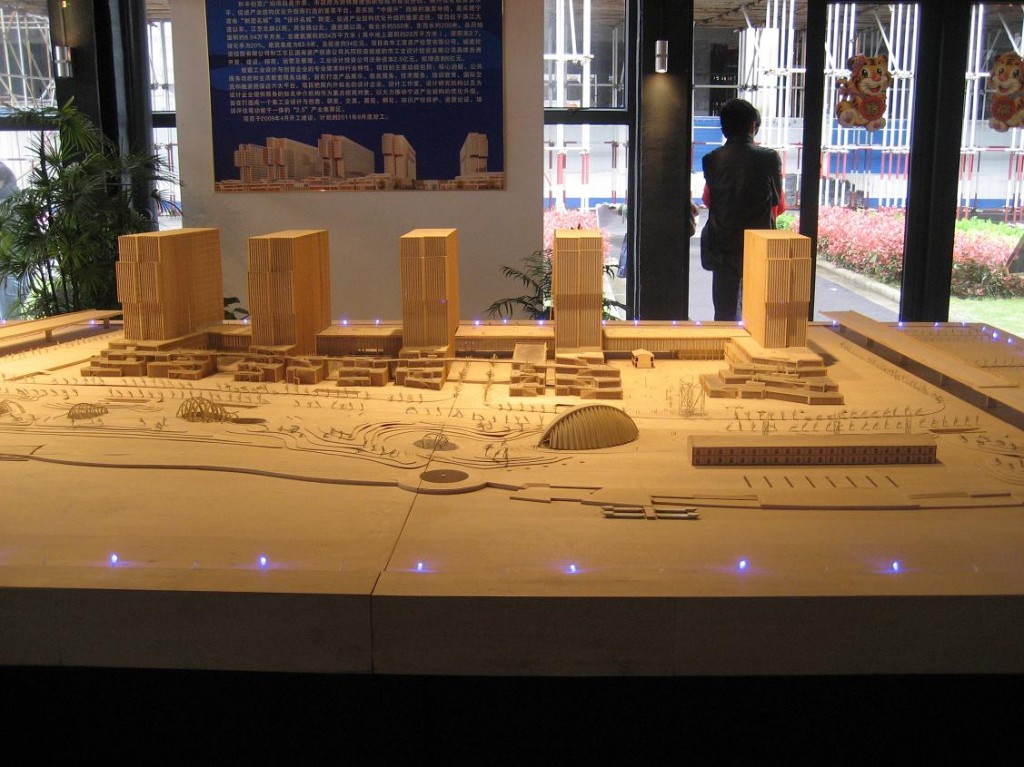
(Picture No.1: The Planning Map of Hefeng Creative Square)
The planning map demonstrates the square with a large plot in territory. Moreover, Hefeng creative square is not positioned as a simplex creative cluster, but integrated with commercial-oriented use like restaurants, hotel, shopping centre, and entertainment. The mode refers to the urban planner’s additional proposal that, besides the creative industries, they also conspire to develop real estate industries, commercial industries and tourism industries as well.
3.2 Phase two: Book City
The second spot is Book City. It is one of key culture and creative projects promoted by Ningbo Government. Situated oppositely to Ningbo Laowaitan, the site was once the flour factory of Ningbo. As same as Hefeng Creative Square, the structure of Book City is weaved as a matrix bonded culture and creative industries with commercial industries. The project of Book City is near to completion, and the key building which is the biggest one just celebrated its opening to public. To brand its culture meaning, Book City is titled as “City Reading Room on East Bank of Yong River †(CNNB 2010); for commercial promotion, it again advertise with “The First Culture, Tourism, and Commercial Plaza on Mouth of Three River†( Book City Billboard 2010, pic 2).

(Picture No.2: The Billboard Advertisement of Book City)
Since it is partially launched on business, we arrived at the site and did some anthropologist investigation. Next to Book City there is one normal-leveled residential community, so most retails around are accordingly small and simple ones including clothing shops, convenient stores and casual eating places. However, the propaganda of Book City promotes that the street beside will be the city’s future culture corridor. The most immediate effect observed on site is that some shops are closed for redecoration (maybe to upgrade); some change the business types. Moreover, we randomly interviewed some shop owners, some of them are optimistic about the benefits bought by Book City, for example, the existing restaurants; some complained the increased rent, such as low priced clothing shops.
In the case of Book City, the finding is to some extent the evidence to Keane’s argument that the Chinese experience of Creative Industries is mostly the Culture Industries (2009b). To decode the culture and creativity in a semiotic approach, these old buildings and old plants while transforming to the culture and creative cluster, it has become the visible imaginary symbols of the city culture and social experience.
3.3 Phase three: Fortune Creation Harbor
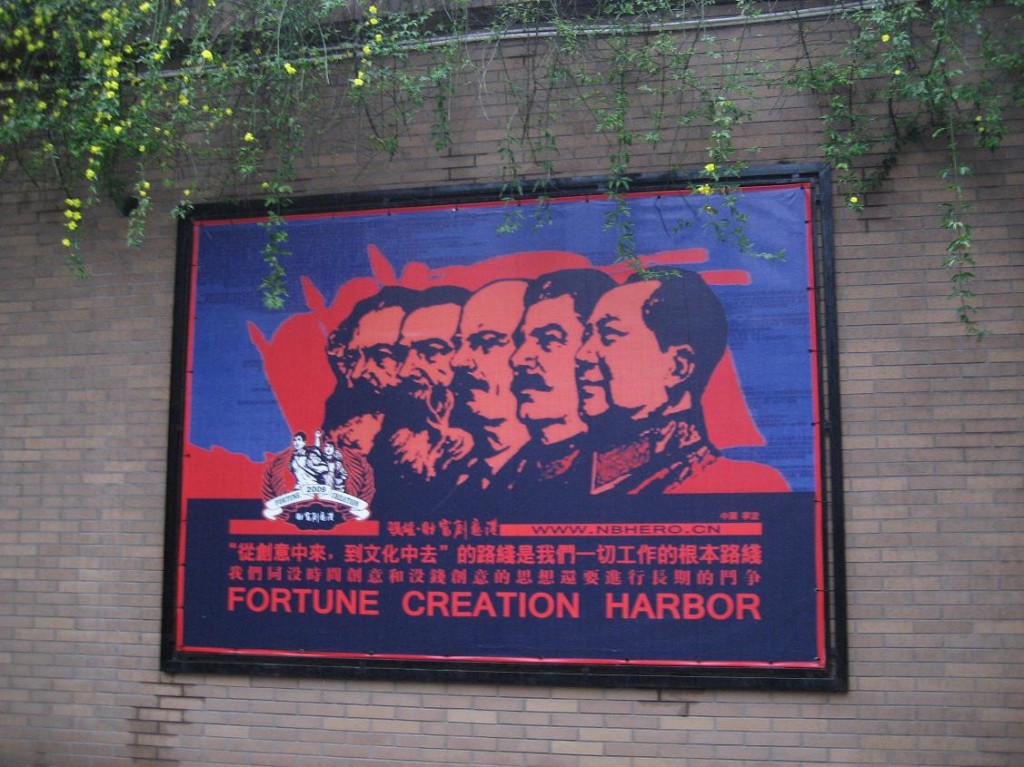
(Picture No.3: The Billboard Culture of Fortune Creation Harbor)
The last observation site is Fortune Creation Harbor situated in the North Bank Fortune Centre near to Ningbo Great Theater. At a first sight of the North Bank Fortune Centre, we noticed that though it covers huge territory with several high-end complexes, some offices seem empty and few pedestrians could be observed on site. When we get close to Fortune Creation Harbor, the situation is exactly the same, some companies removed out, some with no clue or little connection with creative industries.
Referencing to the initial design of Fortune Creation Harbor, it was once a key creative industries project promoted aggressively by Jiangbei government. The third picture attached above should have witnessed the prosperity once upon the time. However, two year later, the place shows more deserted and silent. It has failed to live up to the ambitions of their planners. We assume that this concerns much with the planner’s strategies for positioning the place. The basic mode is the same as of Hefeng Creative Square and Book City, to establish a comprehensive industries center, and the aim is to present a perfect package for attraction from real estate speculators and capital investor. Backed up by conspicuous state investments and by fast decision making, the areas have been transformed and neighborhoods have been revitalized, infrastructure has been upgraded. Unfortunately, a great leap forward can not guarantee a long term benefit.
Conclusion
In conclusion, to apply the concept of parasitic exploitation of symbolic capital (Pasquinelli 2006), the mode of development of creative clusters in local Ningbo seems a contradictory and conflicted. It confirms the situation of Ningbo’s creative industries that the culture and creative economy-oriented project is possibly exploited mostly by real estate speculators and leave little space for sustainable development of culture and creative reproduction.
Using the creative industries as overwrap, and then packaging the commercial oriented industries into creative economics, such a development mode of creative industries was copied by a lot of followers. As in Ningbo area, we’ve observed Loft8, Creation harbor and Creative 3rd plant established one and another designed in similar way. In a first sight, such creative industries may bring instant benefit as it successfully promotes the real estate speculation. However, the more in-depth and profound effect should be questioned and highlighted: how long could this mode of “fake†creative industries further go?
References
Berghuis, T, J(2008), ‘Constructing The Real (E)state of Chinese Contemporary Art: Reflections on 798, in 2004′ , Urban China 33 [Special Issue: ‘Creative China: Counter-Mapping Creative Industries’].
Borg, J, Tuijl, E and Costa, A, 2010, Designing the Dragon or does the Dragon Design? An Analysis of the Impact of the Creative Industry on the Process of Urban Development of Beijing, China, Retrieved May, 2010 from
http://www.dse.unive.it/fileadmin/templates/dse/wp/WP_2010/WP_DSE_borg_tuijl_costa_03_10.pdf
CNNC,2010. Special Website for Book City, Retrieved May, 2010 from
http://zt.cnnb.com.cn/system/2010/04/23/006500222.shtml
DCMS (2001), Creative Industries Mapping Document 2001 (2 ed.), London, UK: Department of Culture, Media and Sport, Retrieved May, 2010 from http://www.culture.gov.uk/reference_library/publications/4632.asp
Flew, T. 2009. ‘The cultural economy moment?’ Cultural Science. Retrieved May, 2010 from http://cultural-science.org/journal/index.php/culturalscience/article/view/23/79
Flew, T. 2010. ‘Toward a Cultural Economic Geography of Creative Industries and Urban Development: Introduction to the Special Issue on Creative Industries and Urban Development’, The Information Society, 26: 2, 85 – 91. Retrieved May, 2010 from http://dx.doi.org/10.1080/01972240903562704
Florida, R. 2003 The Rise of the Creative Class. New York: Basic Books
Harvey, D. 2001, ‘The Art of Rent: Globalization and the Commodification of Culture’, in Spaces of Capital: Towards a Critical Geography, New York: Routledge, 2001, pp. 394-411
Keane, M. 2009a ‘Creative industries in China: four perspectives on social transformation’, International Journal of Cultural Policy, Vol. 15, No. 4, pp. 431–443
Keane, M 2009b ‘Understanding the creative economy: a tale of two cities clusters’. Creative Industries Journal, 1(3). pp. 211-226.
Landry, C. 2000. The creative city: A toolkit for urban innovators. London: Earthscan
Lovink, G and Rossiter, N (eds) 2006, ‘MyCreativity: Convention on International Creative Industries Research’, MyCreativity Reader: Critique of Creative Industries, Amsterdam: Institute of Network Cultures, pp. 241-247.
Pasquinelli, Matteo (2007) ‘ICW-Immaterial Civil War, Prototypes of conflict within cognitive capitalism’, in Geert Lovink and Ned Rossiter (eds) MyCreativity Reader: Critique of Creative Industries, Amsterdam: Institute of Network Cultures, pp. 71-81.
Porter, M. 1998. ‘Clusters and the new economics of competition’. Harvard Business Review 76:77–91.
Rossiter, N. 2008, Counter-mapping Creative Industries in Beijing (Introduction), Urban China, No. 33, December 2008
Schuster, J 2002. ‘Sub-national cultural policy—Where the action is? Mapping state cultural policy in the United States’. International Journal of Cultural Policy 8:181–96
Scott, A,J (ed) 2001. ‘Global city-regions’. In Global city-regions: Trends, theory, policy, pp11–30. Oxford: Oxford University Press.
Scott, A. J 2008. Social economy of the metropolis: Cognitive-cultural capitalism and the global resurgence of cities. Oxford: Oxford University Press.
Zukin,S 1989. Loft Living Culture and Capital in Urban Change. Rutgers University Press
Posted: May 13th, 2010 | Author: yangwu | Filed under: creative industries, real-estate, video | No Comments »
This documentary follows the topic on the Creative Industries in relation to urban reconstruction and land development. In the process of Ningbo’s city development and urban renewal in the recent years, one would witness that the Creative Industries plays an active and significant role and potentially processes economic, political or social power.
The argument embedded in the documentary is that the Creative Industries, for one hand, is a set of economic form, able to generate economic growth and contribute to labor employment; on the other hand, it is also a tool, used to cover the underneath strategies for coalition between local government, real estate developer and commercial industries.
In order to visually present the argument and demonstrate it in a convinced and easily understood way, the project of Book City is selected as an example for assessment.
Here is the documentary, enjoy~~

Posted: April 25th, 2010 | Author: yangwu | Filed under: creative industries, real-estate | No Comments »
In the article, Pasquinelli revisits David Harvey’s work of The Art of Rent (Harvey 2001), claiming that “all the immaterial economies have a material, parallel counterpart where the big money is exchanged†(Pasquinelli 2006: 22). The mode of value generation in creative industries domain is in fact not limited to the exploitation of intellectual property, but also a more tendentious way of parasitic exploitation by another material objects. The discourse “collective symbolic capital†introduced by Harvey unveils the potential political economy of cultural interventions and the parasite exploiting the social creativity.
The culture context provides the marks of distinction which be exploited further by capitalists to sell material goods. The article mentions the Barcelona city as an example; Pasquinelli states that the production of culture as social capital and real estate speculation is a couple of immaterial and material compound.
To apply the concept of parasitic exploitation of symbolic capital, the mode of development of creative clusters in local Ningbo seems a contradictory and conflicted circumstance for further investigation. An initial thought of this phenomenon is that the culture and creative economy-oriented project is possibly exploited mostly by real estate speculators and leave little space for sustainable development of culture and creative reproduction.
References:
Harvey, David (2001), ‘The Art of Rent: Globalization and the Commodification of Culture’, in Spaces of Capital: Towards a Critical Geography, New York: Routledge, 2001, pp. 394-411
Pasquinelli, Matteo (2007) ‘ICW-Immaterial Civil War, Prototypes of conflict within cognitive capitalism’, in Geert Lovink and Ned Rossiter (eds) MyCreativity Reader: Critique of Creative Industries, Amsterdam: Institute of Network Cultures, pp. 71-81.
Posted: April 25th, 2010 | Author: yangwu | Filed under: Uncategorized | No Comments »
“These days, the experimental art scene is reinventing itself as a highly profitable and marketable, commercial cultural industry.â€
– Berghuis, 2008
The main argument of Berghuis to the art district like Dashanzi is that he found the most fundamental and essential development occurring here is in deed the real estate industry more than a contemporary art industries. Though, the place like Dashanzi district started as an experimental art basement of artists’ initiative, but it now ends up a trendy cultural cluster and commercial district whose biggest beneficiaries are property dealers. The loser could be the artists who contributed to the reborn of 798 art factory but eventually have to be driven off by the increasingly raised residential rent. In fact, the distinct culture context or creativity brand helps promoting the real estate speculation and generates a compound economy of creative industries and commercial industries.
Using the creative industries as overwrap, and then packaging the commercial oriented industries into creative economics, such a development mode of creative industries was copied by a lot of followers. As in Ningbo area, we’ve observed Loft8, Creation harbour and Creative 3rd plant established one and another designed in similar way. In a first sight, such creative industries may bring instant benefit as it successfully promotes the real estate speculation. However, the more in-depth and profound effect should be questioned and highlighted: how long could this mode of “fake†creative industries further go?
Reference:
Berghuis, Thomas J(2008), ‘Constructing The Real (E)state of Chinese Contemporary Art: Reflections on 798, in 2004’ , Urban China 33 [Special Issue: ‘Creative China: Counter-Mapping Creative Industries’].
Below are some pictures took from Creative 3rd plant.

The Cluster Name: Creative 3rd plant

The location is formerly the No3. plant subordinate to Shanghai drawnwork import and export company

Building No1 is right now repacked to a hotel.

Some are lofts for design companies.

Insider there is a new-concept restaurant; about 100rmb per capital consumption.

The ceiling of restaurant keeps the original of old factory
Posted: April 25th, 2010 | Author: yangwu | Filed under: maritime industries | No Comments »
On 23rd Apr, UMN team made a third field trip. The aim of trip is to learn more about Ningbo Maritime industries and investigate the routine duties and working conditions of the involved labours. About the observation spots, we chose two companies as they are in different roles and with different environmental cultures within logistics industries. Group A including Ned, Angela, Yulin visited Ningbo branch of CMA, one of world’s largest shipping companies; Group B, Mukda and I, visited one local logistics agency named Ningbo Maoyu International Freight Agency. To briefly compare two companies, the former is obviously bigger in size and more cosmopolitan of corporate culture; CMA is a shipping company providing carrier service for transporting goods and Maoyu is a forwarding agency which in fact doesn’t have cargo but only work as a coordinator linking and smoothing the communication between shippers, carriers and other relevant links within the whole logistics network.
As located in Ningbo, Maoyu starts its business on the base of geographical advantage with local foreign trade economics and maritime economics. For one end, it has a big market of exporting customers; for the other end, the Ningbo port brings about a plenty of shipping companies to forward the products internationally. Maoyu as well as most logistics agencies find their business opportunity from connecting these links, so the communication efficiency is one of the most important tasks for them. As for routine duties, the different role in company has different job. For example, sells men to find customers, buyers to compare and negotiate forwarding prices with different shipping companies, and then, after order is placed, the documentation specialists to deal with booking, cargo trailer, customs declaration, commodity inspection and etc.
Because Maoyu is not a big company and quite a free styled privately-owned enterprise, the working environment is casual and eased. No formal dress is requested and non business talk is fine as well. Meanwhile, there is no KPI (Key Performance Indicators) or ERP (Enterprise Resource Planning) to systematically measure the employees’ performance but only depending on customer numbers, profit margin, workload and working behaviour. The only visible measurement on site is clocking machine. Though the physical environment seems quite informal here, the working pressure still exists everywhere. For sells man, they have to keep good relationship with existing customers and search for new ones; for buyers, they have to negotiate lower prices from shipping companies so as to compete with other forwarding agency; for documentation specialists, their job is most detailed and trivial, so intensive concentration and well-organized personality are requested. For all of them, working over-time or working outside workplace is quite normal.
Besides with social ability, computer skill is also a very important way to increase communication efficiency. Instant massager like MSN or QQ are used to not only timely report updated information to customers, but also track and trace shipment from carriers. Other software like Cargo2000 as an internal data system and communication platform can help keep the orders systematically and follow up the processing more easily.
From the field observation of Maoyu International Freight Agency Ltd, we learned that such a small but well functioned company can also do a good job in connecting logistics network and keep every shipment forwarding smoothly. The only product provided by this freight agency is service. The service suppliers themselves is also another type of logistics, more preciously, the logistics of communication. While cargo is forwarding the goods between disconnected destinations, the labour of freight agency is shipping the communication within disconnected links in maritime industries.
Below is a short video recording the working state of a documentation specialist
(while keying in the information to data system on computer, she is calling for the update on QQ)
SA500013
Posted: April 18th, 2010 | Author: yangwu | Filed under: creative industries, waste industries | No Comments »
On 9th April, Ned and UMN team scheduled a second field trip for the e-waste topic. Since unfamiliar with e-waste industries at the very beginning, we have done the preparation with not so wise strategies. When I got contacted with one proposed observation spot, a metal waste treatment park, I asked directly about e-waste recycling treatment, and the park personnel denied immediately and explained that it’s because e-waste is illegal to import and the park is mainly dealing with the imported metal waste, so they don’t do e-waste at all. I followed a question of what exactly metal waste in the park. They range from discarded steel and copper to other semi-deconstructed metal waste, for example, some wasteful part of cars or an electrical motor from huge equipment. In fact, it’s hard to distinguish electronic waste from others. The personnel also admitted that sometimes their shipments may have some e-waste inside, but there is pretty small part otherwise custom would detect and forfeit the whole shipment. The final question is asked about that if those waste are not completely de-constructed and then how they deal with them. The personnel confirmed only manual redistribution by workers for current stage. With this telephone interview, as we were informed no e-waste spot could be available to visit, we gave up the original proposal. However, in the class discussion later on, our team member Angela provided some important information from her friend who works in the park confirming that there are some factories doing e-waste treatment informally.
The final field trip was to visit some second-hand electronic product (e-product) markets. In the morning, we firstly visited Tianyi Digital Plaza and then YiGao Digital Plaza. Both sell brand-new e-products, repair the broken, purchase the old and resell the second-hand. When we visited the floor especially bearing upon old e-products, we randomly interviewed some shop owners while not so many of them willing to answer our questions. We learned that currently the old product sources are mainly from domestic, and just a few from the foreign countries which is less and less because of the channel to get them is illegal (the same reason mentioned by the personnel from waste park). We also found even in a small market, there exist some business chains. For example, some only repair the chip-boards for second-hand e-product shops.
After team lunch, Mukda, Yulin and I visited South Gate Market, the biggest old product market in Ningbo. We could see a lot of old products sold or discarded by their previous users redistribute there, some lots of crashed televisions, some for air conditioners. We tried to search second-hand e-product shops, but, quite rare could be found before we jumped in the one introduced by a friend who had experience buying old stuffs here. Afterwards we understood that the declining number of second-hand e-product shops is because of less profit margin squeezed by decreased prices of new e-products and less customers. We chatted with staffs there and watched them working on the site. They introduced that after collecting back some old products, the first step is to de-construct each part and test performance. If any part is broken, they will try to repair or get a replacement. Then, it will be cleaned and reassembled to a well-functioned one for customer selection. Regarding those useless parts or unsold e-products, they consider them as absolute e-waste and move them out. Some junk man from Guangdong province or TaiZhou district would come and collect them. These e-wastes are sold per kilogram, and the prices are quite regularly fluctuated and mostly decided by raw material market. When transported to the following destination, these e-wastes will be crashed down in order to extract metal materials.
During this field, we found two different characters practically bound with these old e-products: e-waste and secondary resource. Regards with the industries chain or network, it might be the end of a chain as so called e-waste; on the other hand, it is the starting point as the secondary resource of a new industry chain.
1. Below are a few pictures of the field work.

TianYi Digital Plaza_Third floor for old e-product market
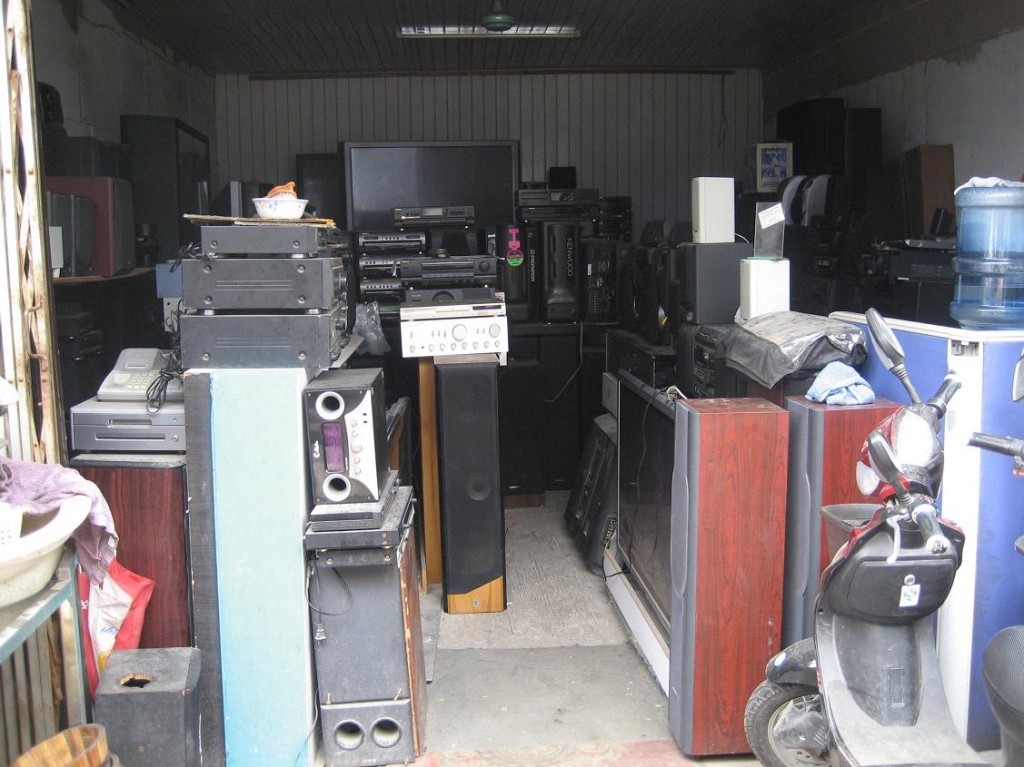
South Gate Market_ A shop corner storing old household electrical appliances
2. some videos from internet highlighting e-waste
HACK – E- Waste
One report investigating e-waste in Australia (then think about China status which is obviously more decades behind)
Pixels
An interesting video metaphorizing the potential destructive power of e-waste.
Posted: April 12th, 2010 | Author: yangwu | Filed under: creative industries | No Comments »
On 2nd April, we, the urban media network team led by Ned Rossiter, carried out a field trip aiming to understand the current situation of Ningbo Creative Industries. Two spots were selected as samples for observation: HeFeng Creative Square and Fortune Creation Harbor. The former one is still on construction, scheduling to open in 2011. The later has on business since June, 2008.
HeFeng Creative Square is located in the east bank of Yao River, opposite to LaoWaiTan. Though only semi-finished architectural complex erects on site, the temporary enclosure wall presents impressive advertisements in order to attract potential companies and financial investment. The stuffs there briefly introduced the industrial property and business scopes of Hefeng Creative Square. With interviewing one of the staffs by Ned Rossiter, we learned the ambition of HeFeng is to establish a flagship industry in providing creative and innovative service to plenty manufactories in Ningbo area, not only compete with local service providers, but also those from Shanghai or others, even foreign countries. When Rossiter asked about what is the decisive advantage for them to compete with other creative clusters. The answer is professional guide and training provided by cluster committee plus the golden location, the center of downtown Ningbo. Since the square occupies a large plot, it will also be integrated with commercial-oriented use like restaurants, hotel, shopping centre, and entertainment.
Later on, we also visit a reserved building whose precursor was a workshop of Hefeng Cotton Mill. It’s now the temporary station for enrolled enterprises. Some are stylish design companies; some are arts and antique stores.
The second spot is Fortune Creation Harbor situated in the North Bank Fortune Centre near to Ningbo Great Theater. At a first sight of the North Bank Fortune Centre, we noticed that though it covers huge territory with several high-end complexes, some offices seem empty and few pedestrians could be observed on site. When we get close to Fortune Creation Harbor, the situation is exactly the same, some companies removed out, some with no clue or little connection towards creative industries.
Referencing to the initial design of Fortune Creation Harbor, it was once a key creative industries project promoted aggressively by JiangBei government. However, two year later, the place even shows more deserted than before. From the field observation, we could assume that Fortune Creation Harbor is somewhat a failure example of creative industries.
Below is the snap show of the field work.
Section 1-HeFeng Creative Square

The planning map showing a large area of territory covered ;

Current Registered Companies Name Wall;

The only one reserved part of old Hefeng Cotton Mill;


Some design companies;


Some art and antique centers;
Section 2-Fortune Creation Harbor

Promotion signboard of Fortune Creation Harbor observed beside Great Theatre;

Mapping North Bank Fortune Centre: a large area of territory and several complexes;


Countless office rooms up there.

The landmark of Fortune Creation Harbor;


Some companies already moved out;

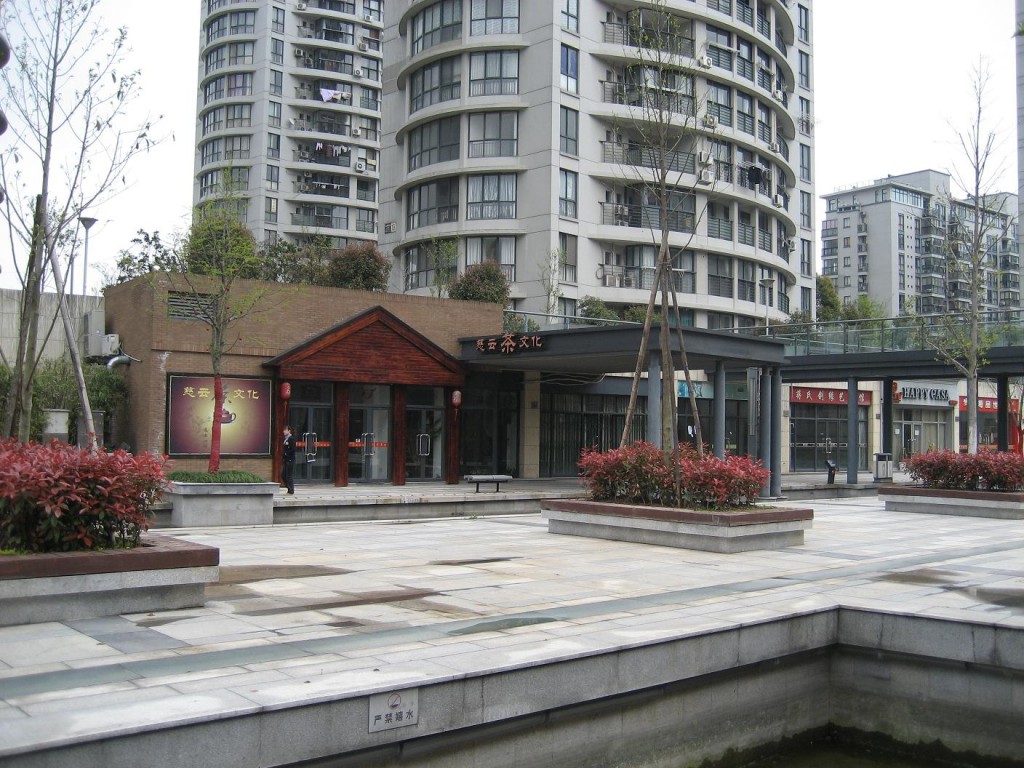
Some show little connection with Creative Industries(might be culture related)
Posted: April 2nd, 2010 | Author: yangwu | Filed under: creative industries, real-estate | No Comments »
As per my own life experience in Ningbo during last several years, this city changed a lot in its urban space formation. A bunch of creative clusters are constructed or on construction. Most of them are rebuilt on the base of closed state-own plants, taking the remaining advantages of centre location and large scale of areas.
The background of this change is obvious. Even in the propaganda painted on the street wall, Ningbo shows strong ambition on driving an industrial structure revolution for its regional economy. Then, aiming to raise the proportion of the tertiary sector and its value-added creating power, the creative industries as one of most rational industry models was awarded high priority and put on a short agenda.
Though the initial proposal of developing creative industries is to generate economy from creativity and innovation, the Ningbo case is much more complicated from our field observation. The creative cluster or park seems mostly be finalized in a complex fashion, including real estate industries and other commercial industries like big shopping mall.
So, my initial thought is to investigate the underlying factors which shift the way how Creative Industries proceed in Ningbo, and try to relate this phenomenon to the study of political economy of space.
Posted: March 27th, 2010 | Author: yangwu | Filed under: Uncategorized | Tags: city image, urbanization | No Comments »
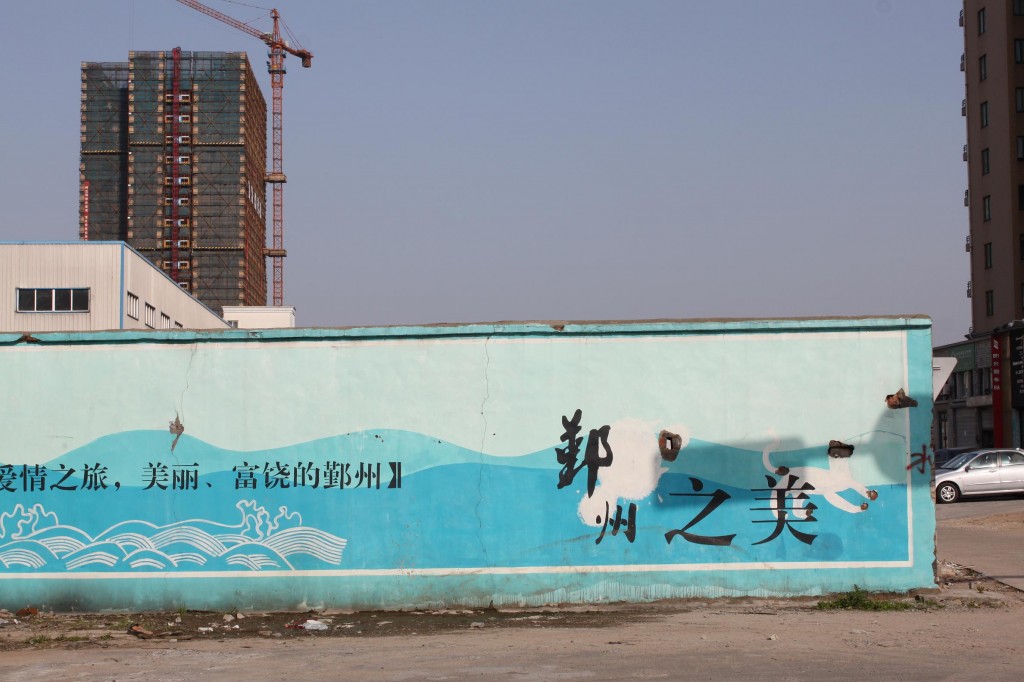
“The Beauty of YinZhou”, is it beautiful in your eye?!
“鄞州之美”,美ä¸ç¾Ž?!
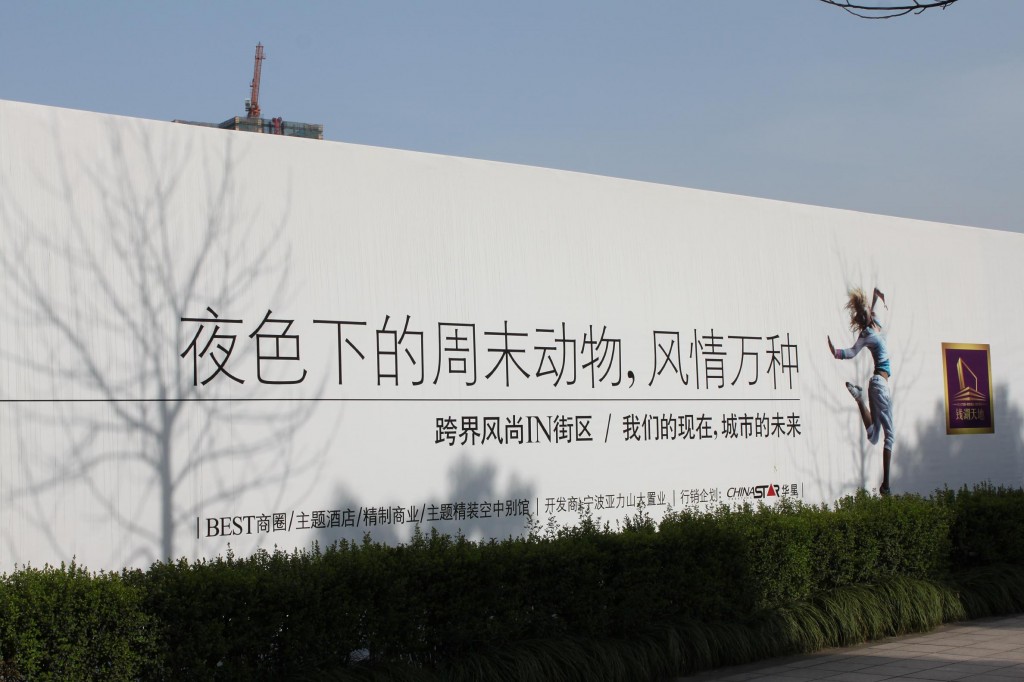
Finally, human being move into the city…and finally humen being evolve to the “animals”?!!…
人类æ¥åˆ°äº†åŸŽå¸‚,进化æˆäº†”动物”?!!~~
(PS, the direct interpretaion of this ad. is: Weekend animals in the night light…are exceedingly fascinating and charming!)
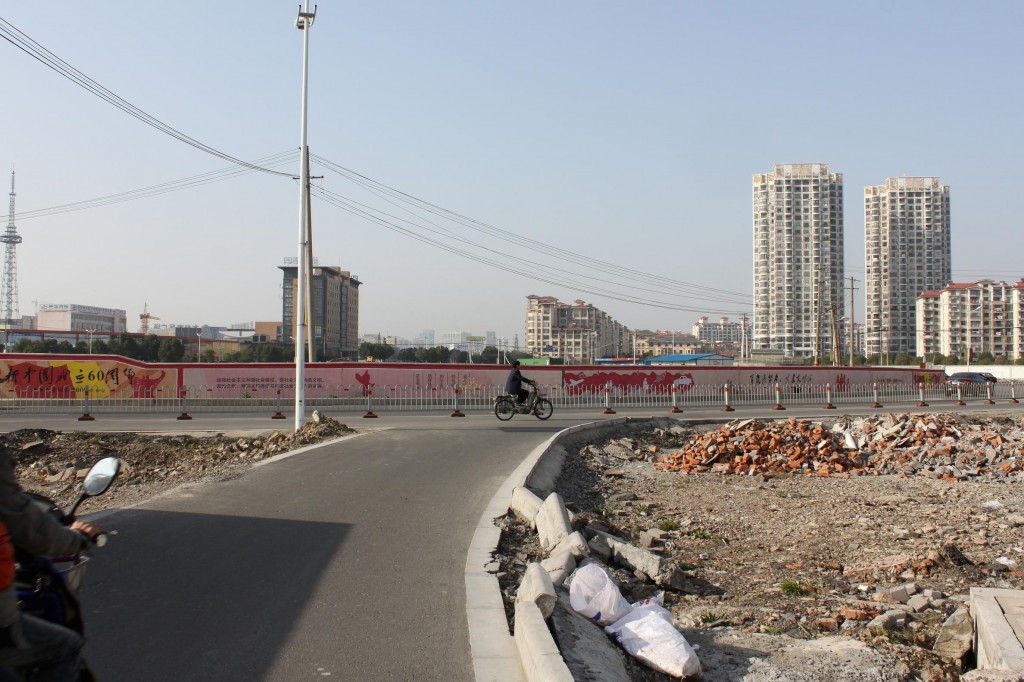
2 functions presented by the wall: enclosure movement+propaganda=legitimacy
一墙两用:圈地è¿åŠ¨+å®£ä¼ å·¥å…·=拆è¿æœ‰é“,æ”¹é€ åˆç†

Rape flowers: Survived after” raped”, still blooming and lovely~~
æ²¹èœèŠ±(英文åRape flower!): “蹂躔之åŽä¾ç„¶åšå¼ºå¹¶ç»½æ”¾ç€~~
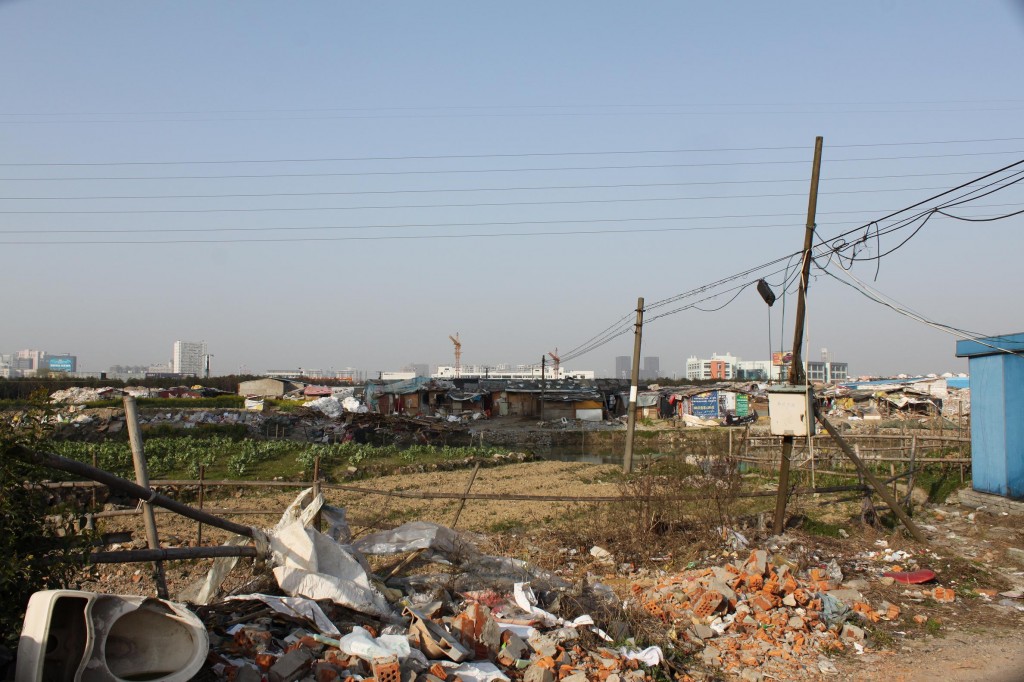
After demolition, before exploitation, it’s the “sweet” home of informal immigrants
拆è¿åŽ,å¼€å‘å‰çš„闲置地是农民工的临时房和èœåœ°.

有人说过:世界上最美的建ç‘是废墟. 更甚, 废墟还有ä¸æ»ä¹‹çµ~~
Someone said that: the most beautiful architecture is the ruins. More than that..this ruin never die~~
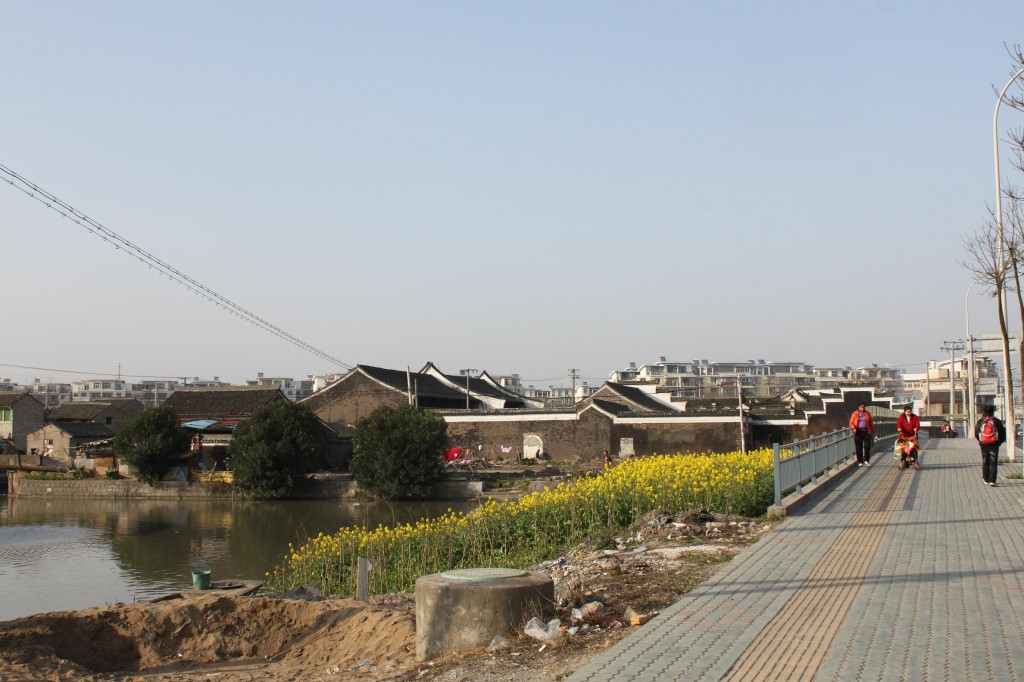
Rarely the case: one lucky ancient town “living” in city~
难得眼å‰ä¸€äº®…ä¿ç•™å®Œæ•´çš„城ä¸æ‘
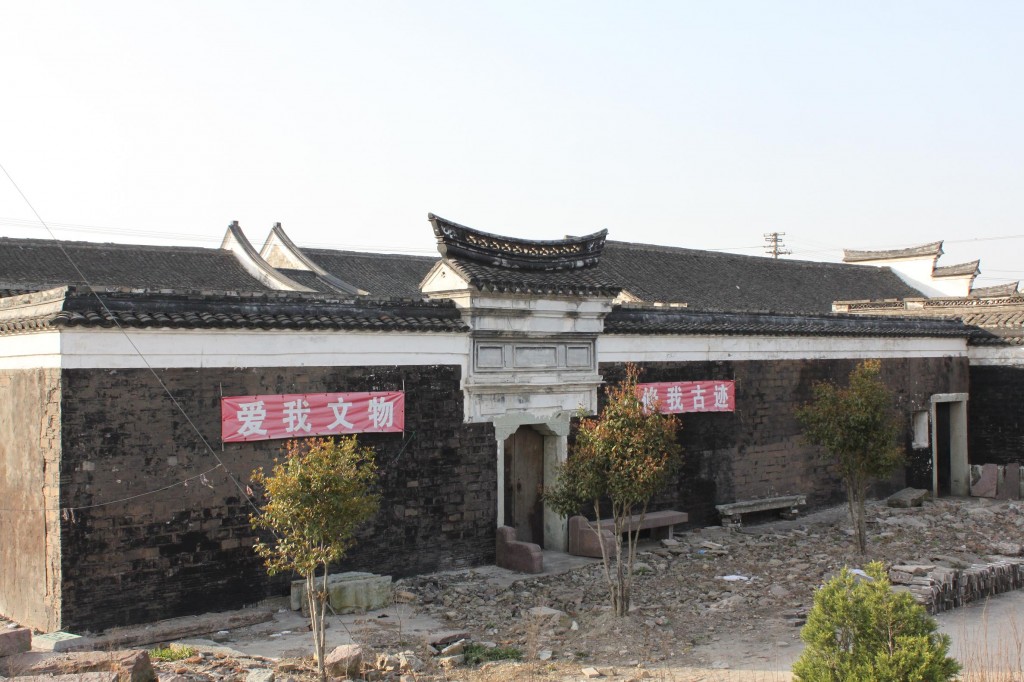
The truth is: we need to “protect” our heritage…but how to define which is heritage and which not?
文化é—产所以留下…å› ä¸ºè¿˜æœ‰ä»·å€¼?
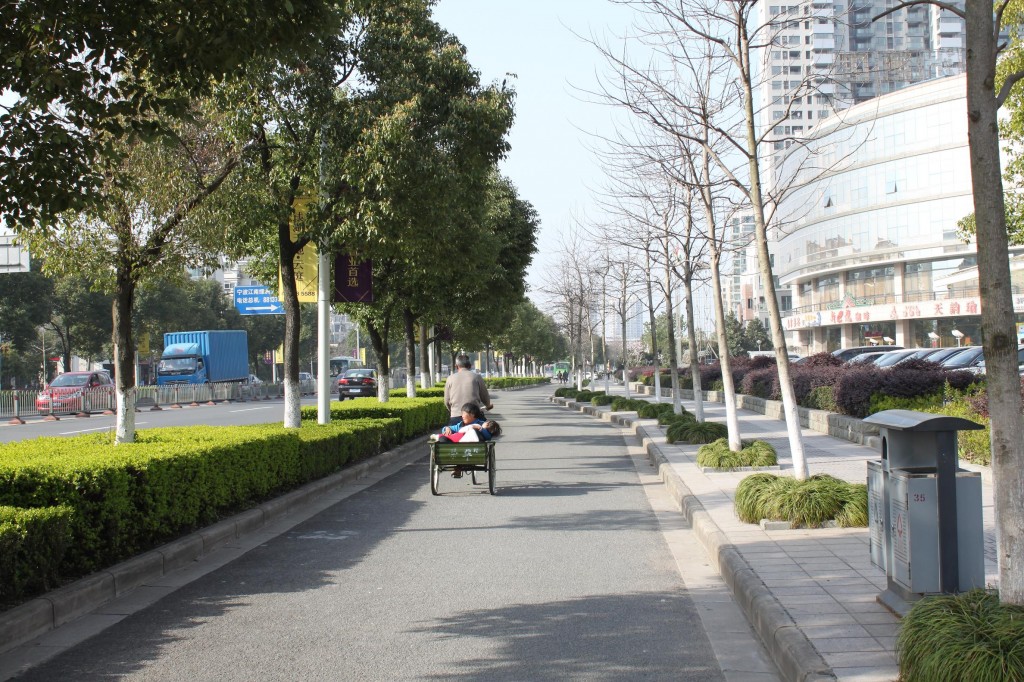
No reason…some part of my heart was touched in this moment!
没æ¥ç”±çš„~~心抽了一下下~
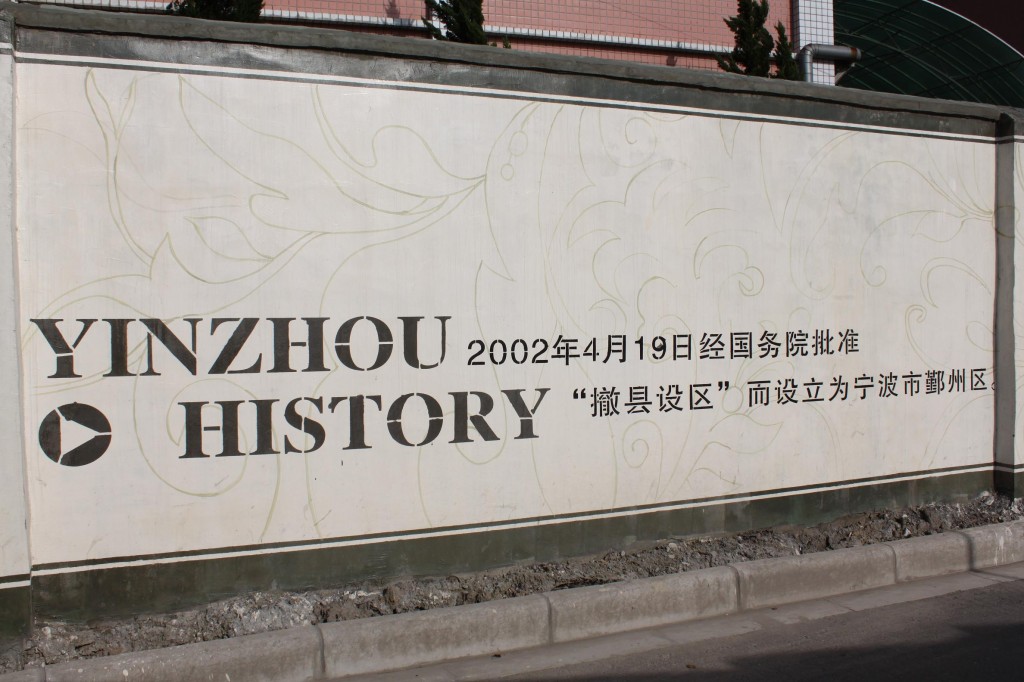
The historic point of Yinzhou urbanization: title changed from “county” to “district”?!
“撤县设区”的历å²èŠ‚点象å¾äº†ä»€ä¹ˆ:城市化?!
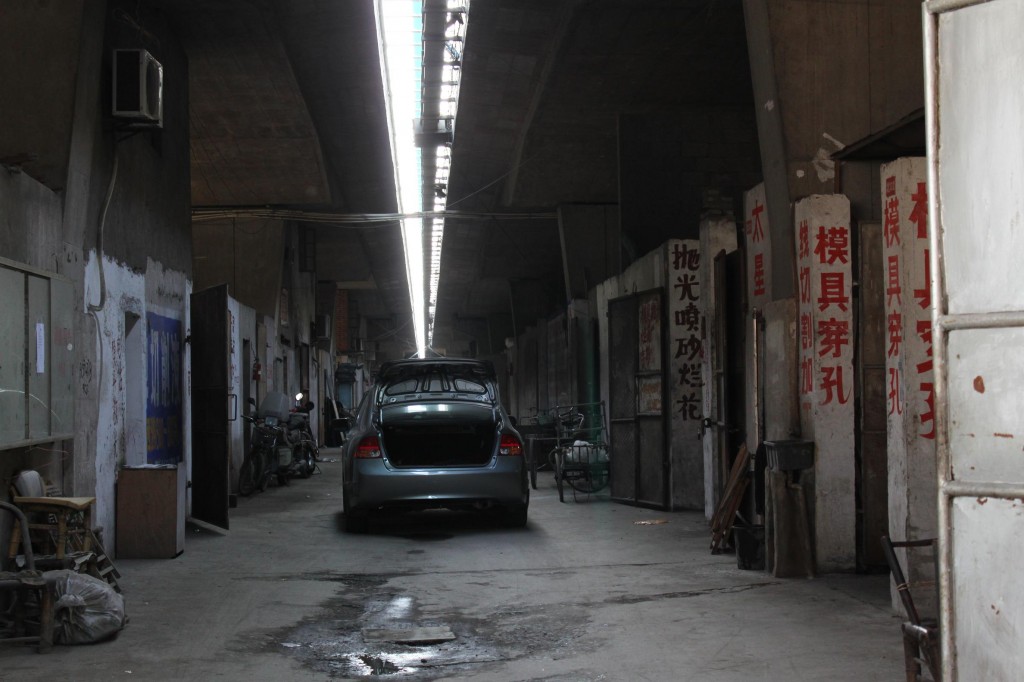
The “economic development zone” under bridge…thanks to the golden land of city
寸土寸金:大桥下的”ç»æµŽå¼€å‘区”
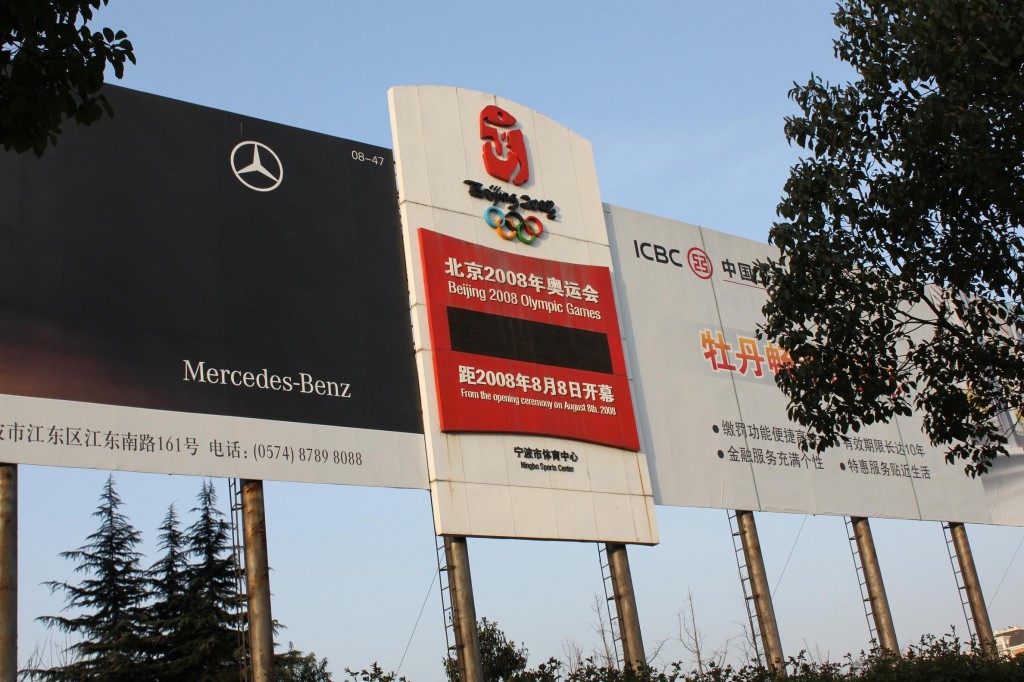
Now, should we count down for what?! Benz, ICBC, or sponsor’s ad expire date?
时间为è°è€Œæ¢æ¥~~奔驰? ICBC?赞助商们?!

Book City
书城
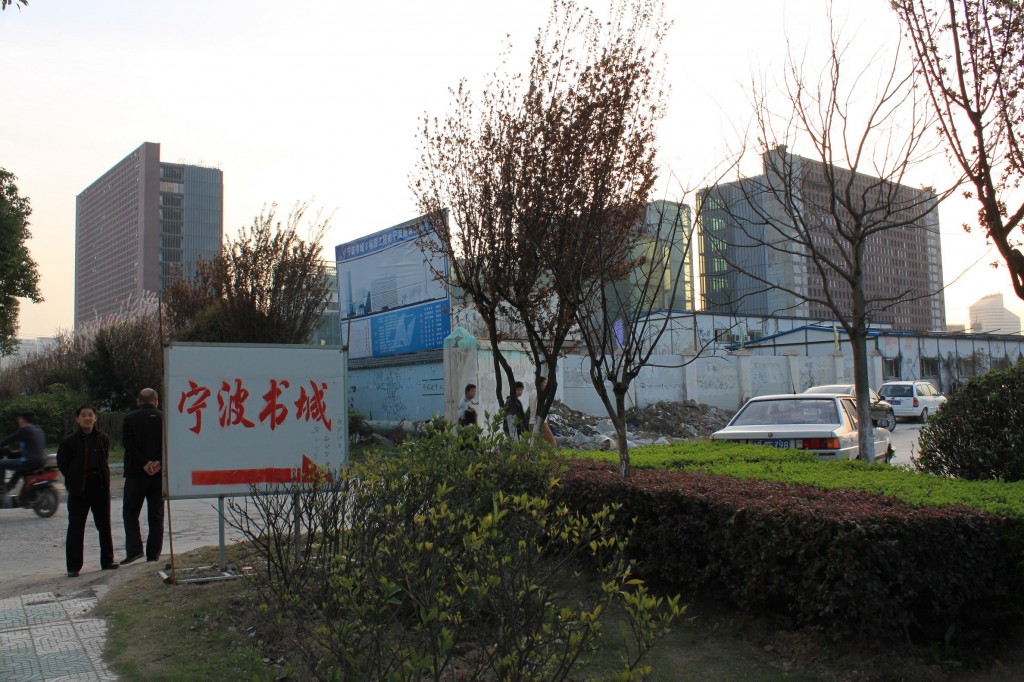
Situated oppositely to Ningbo LaoWaiTan, formerly the place of old flour factory. One vivid comment on this change is very impressive, so allow me to quote here: this plant, before producing food for body, now upgrades to produce food for mind.
ä½äºŽå¤–滩对岸,原é¢ç²‰åŽ‚ä½ç½®. 有ç§è¯´æ³•ï¼Œå€¼å¾—一æ…以å‰ç”Ÿäº§ç²®é£Ÿ~~现在,æ供精神粮食
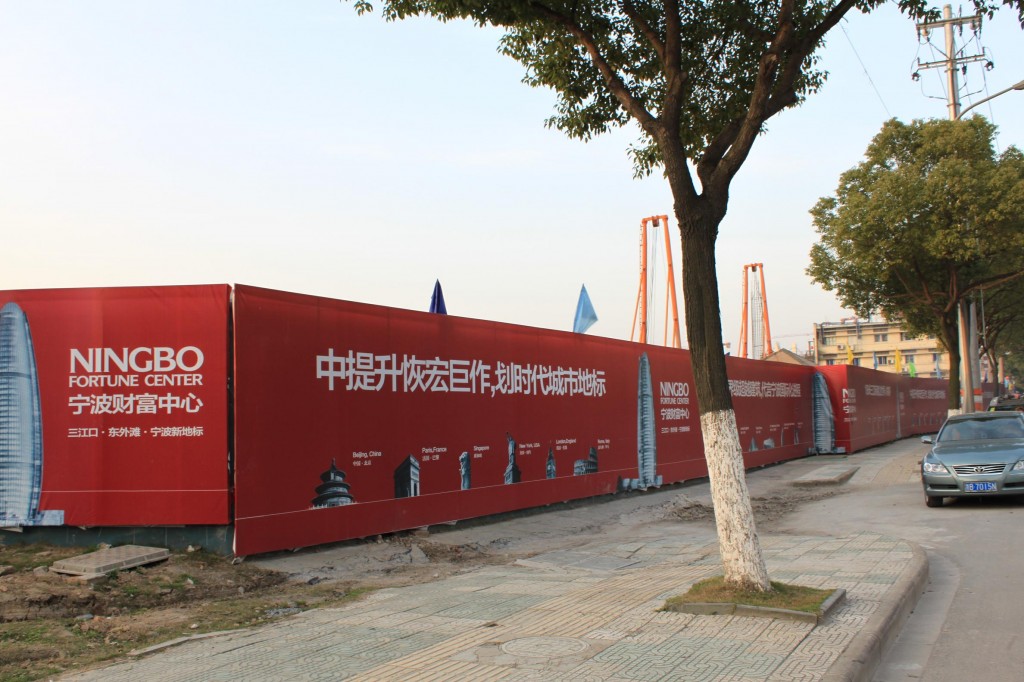
The spot next to Book City is another imaginary landmark of Ningbo: Fortune Centre.The question is, can it be a real name card of Ningbo? Or just another non-place?!
书城下一站,财富ä¸å¿ƒï¼Œå¦ä¸€ä¸ªæœªæ¥çš„å®æ³¢åœ°æ ‡ï¼Žä½†æ˜¯ï¼Œå…¶èƒ½å¦æˆä¸ºä¸€å¼ å副其实的城市å片呢?
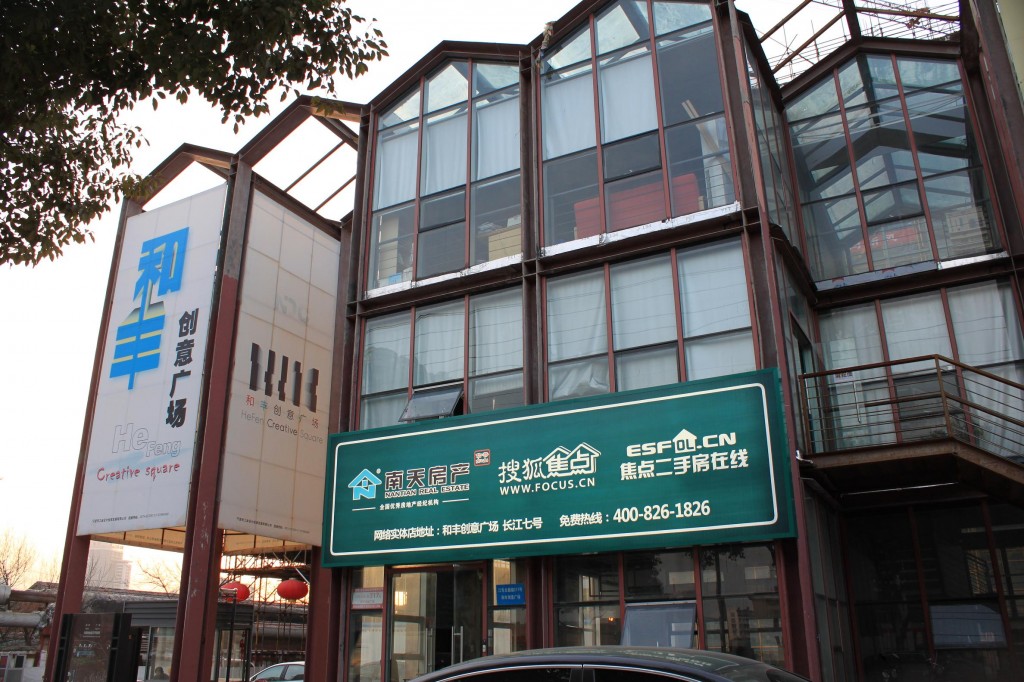
外滩北岸第三站:和丰创æ„广场.
The third spot of this industrial chain is HeFeng Creative Square
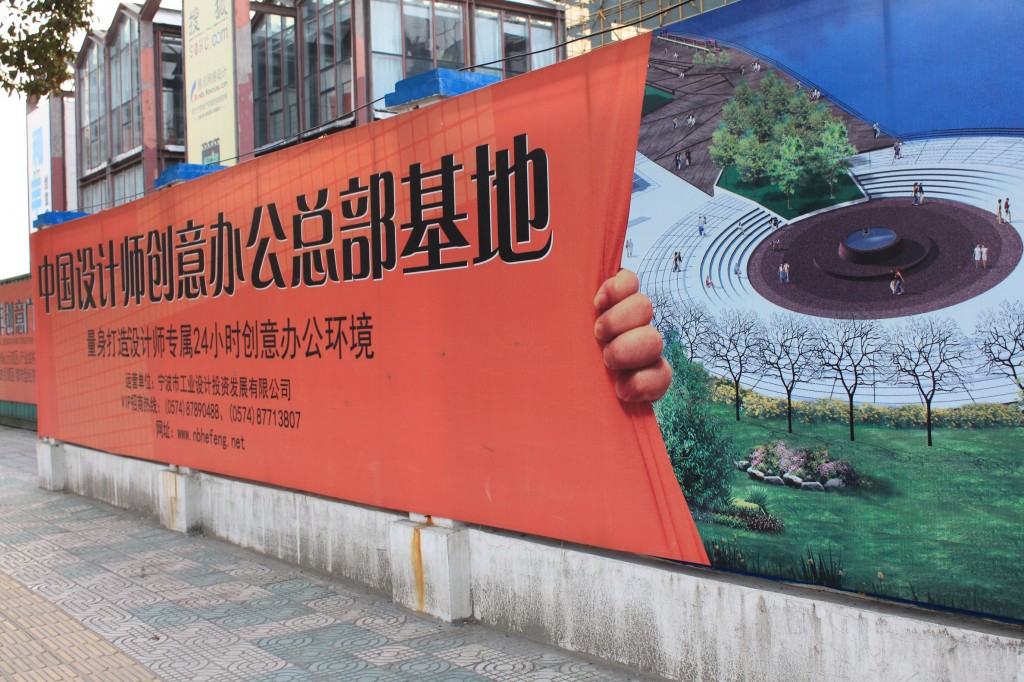
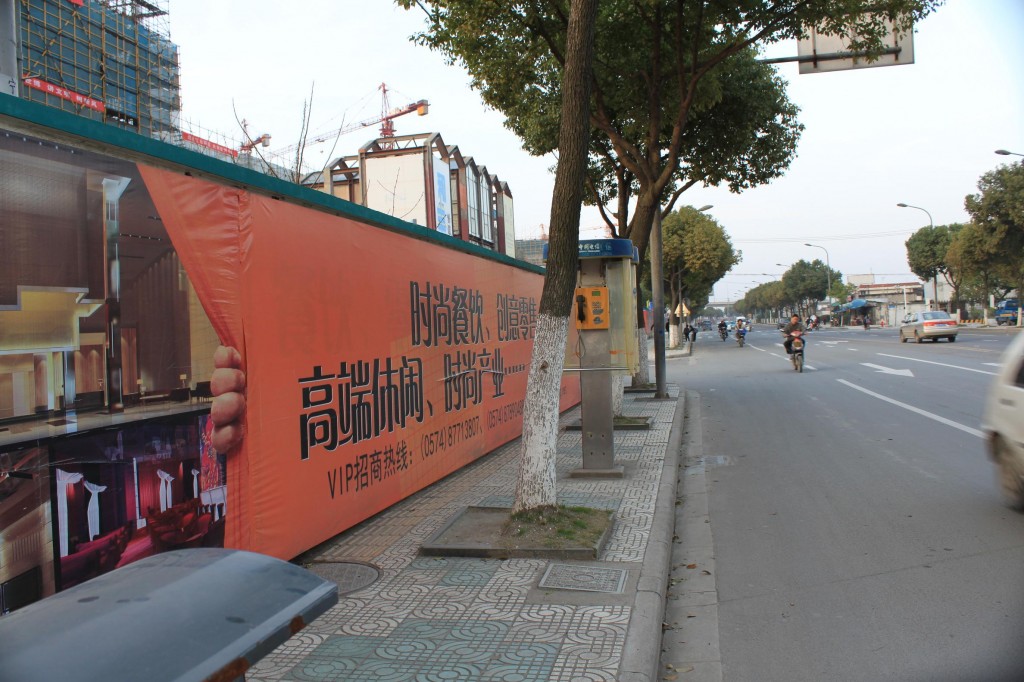
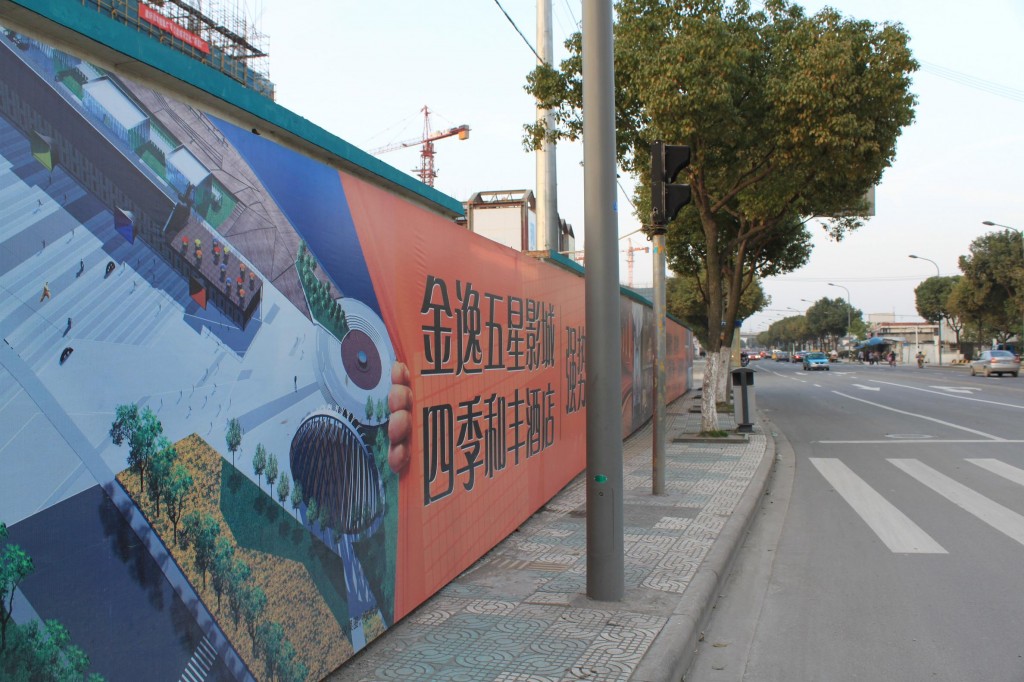
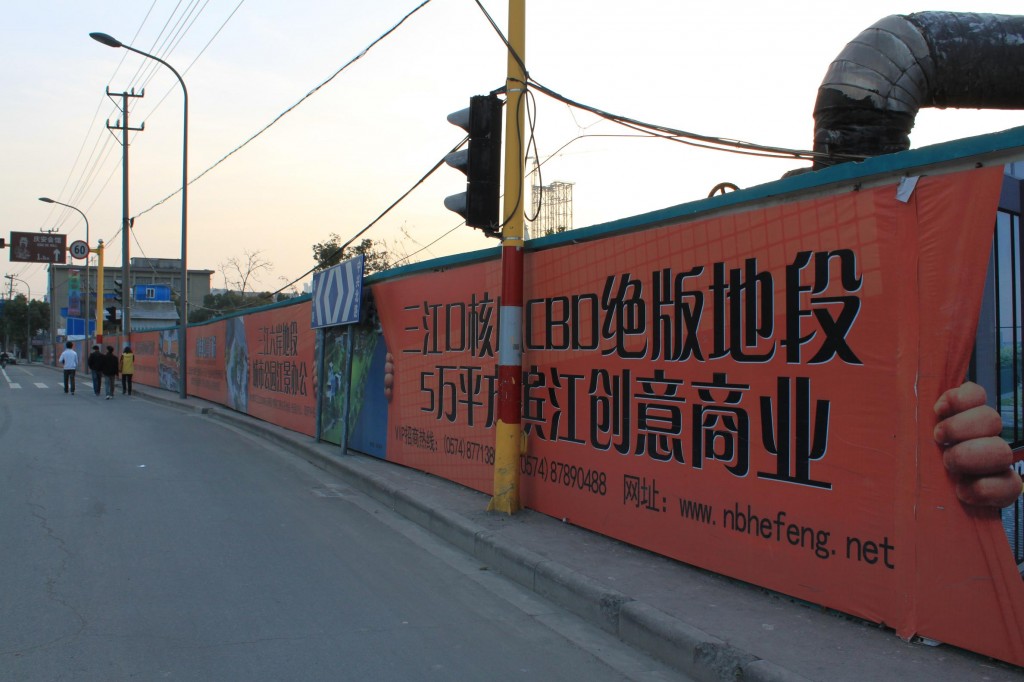
What you can get from a bunch of wall advertisements: creative centre + business centre + city centre=potential stock in real estate?!
丰富的外墙广告:创æ„+商场+地段=地产ä¸çš„潜力股?!
(PS : English version of wall ads.
pic1: The creativity headquater of chinese designers
pic2: stylish resturants, creative retails, high-end leisure centre, and in-style industies…
pic3: JinYi 5 stars cinena and Four Season HeFeng hotel join in.
pic4: Location in the mouth of 3 rivers, scarce and rare lots…
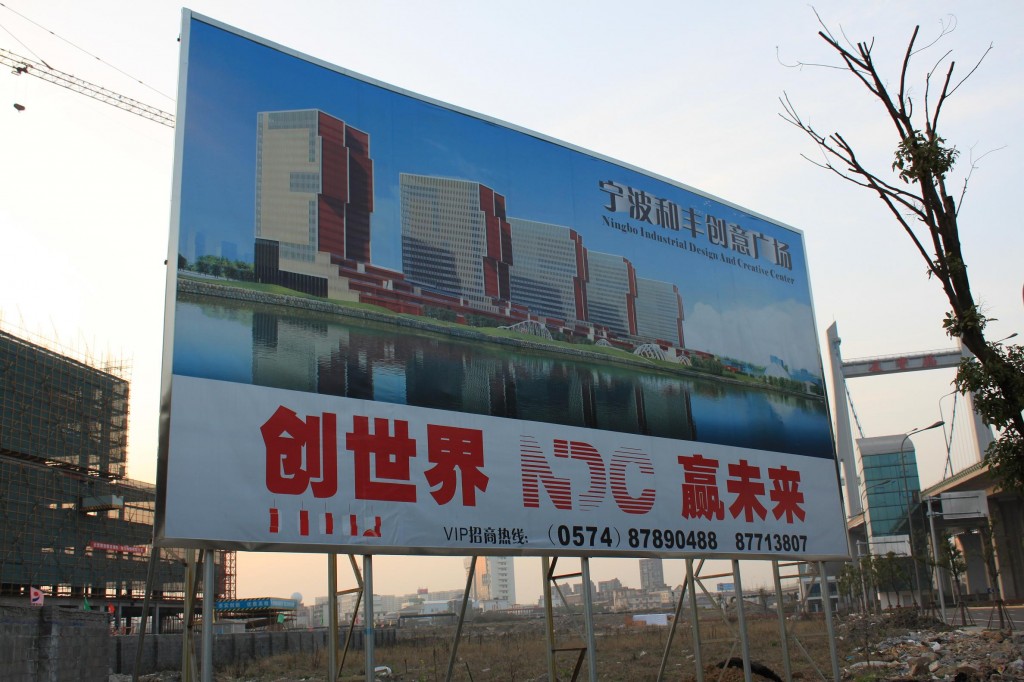
The Slogan: Create World, Win Future
æ ‡è¯:创世界 赢未æ¥
Posted: March 26th, 2010 | Author: yangwu | Filed under: creative industries | Tags: creative clusters | No Comments »
Got a first spot to visit: Creative1956… formerly one of the state-owned factory of transformer manufacturing, now is changing to an imaginary plant for producing creativity…It’s said that this is going to be the largest loft basement in Ningbo~~Should we go and see how is everything going there?!
打å¬åˆ°ä¸€ä¸ªåœ°:创æ„1956~~原å˜åŽ‹åŽ‚改建的~~å¬é—»,è¦æ•´è£…æˆå®æ³¢æœ€å¤§ä¸€LOFT基地…这就去拜访一下å§!
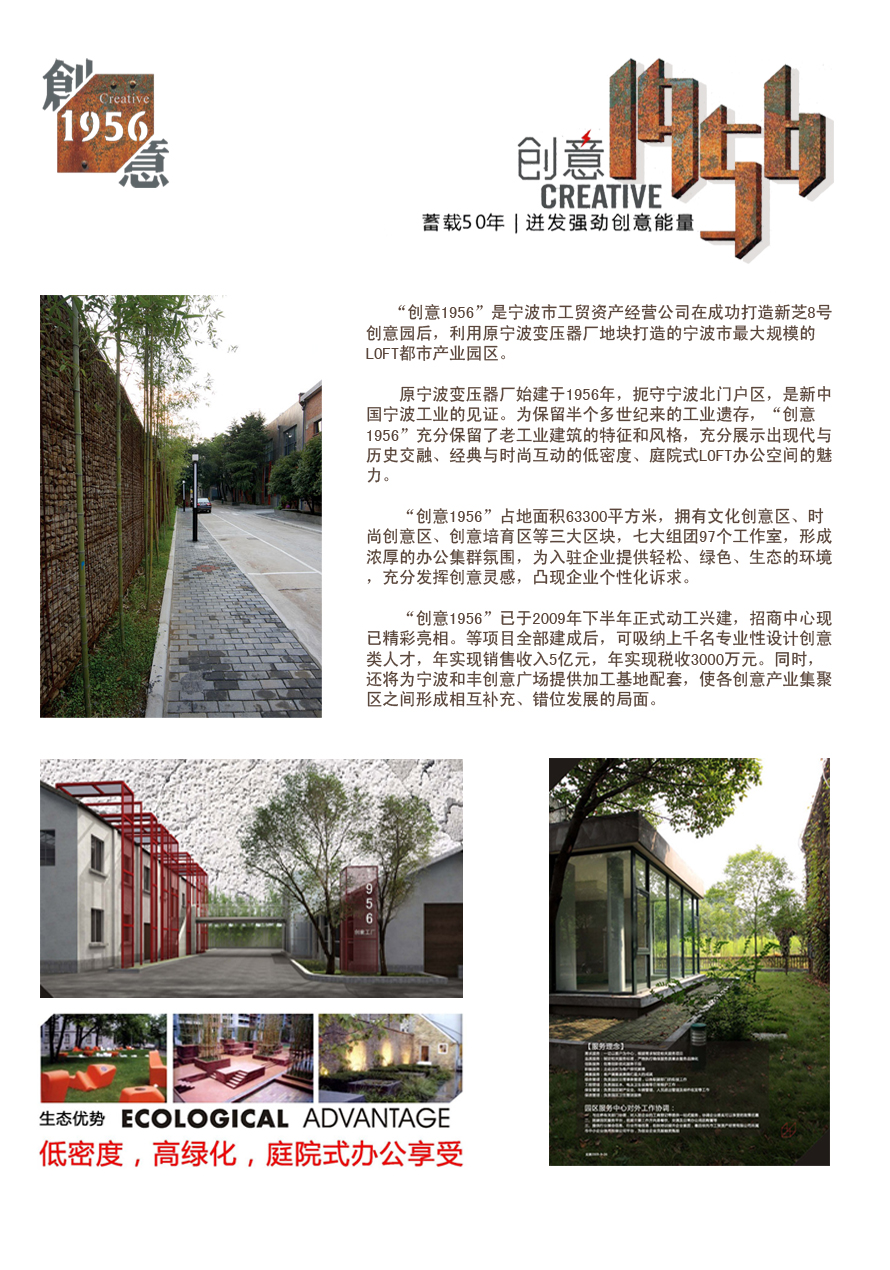
The Planning Map~
规划图~

A first sight, Poor Gate!!… The factory sign was abandoned and took off!~~However, lucky for it, in near future, a new exterior signage will have its new name framed here, reminding the original birthday of this place:1956
å±å’äº†å‡ å年的国è¥å˜åŽ‹åŽ‚!如今,门头也被拆了!ä¸è¿‡ï¼Œæ–°ç‰Œå·åˆ›æ„1956ä¿ç•™äº†å…¶æœ€åŽ†å²çš„部分~~OK啦~

Look from this way (oppositely): green lane …beautiful sight~~~
å¦ä¸€è¾¹çš„风景很好…绿æ„浓浓的林è«å¤§é“~~
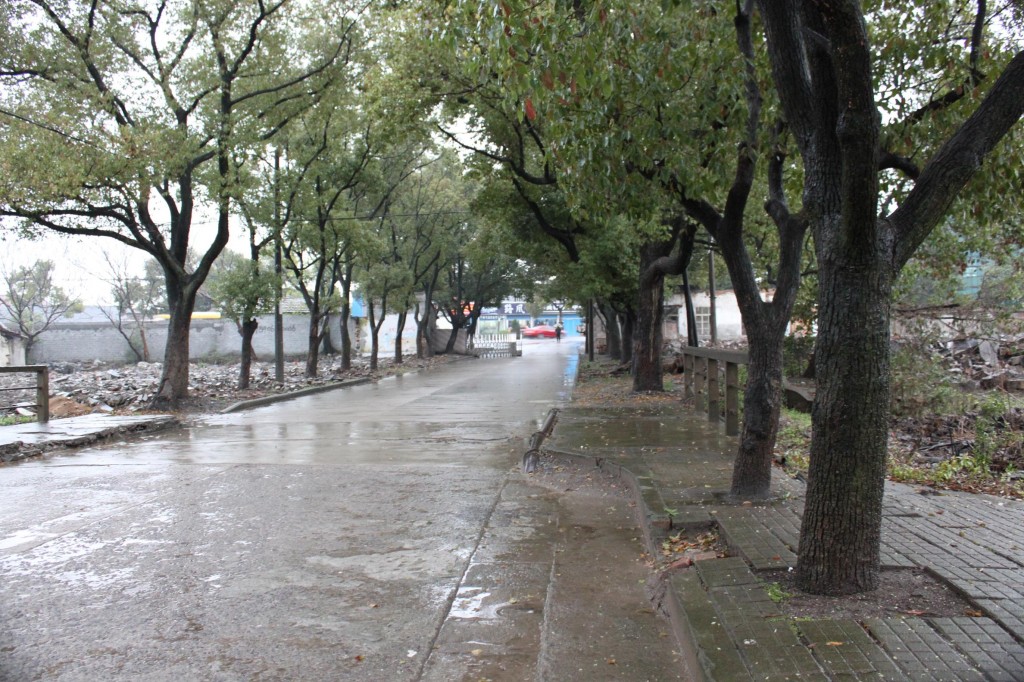
Beside, several boilers still stand erect..Though, it’s of no use now, one might remember its busy days back to the new China’s industrial revolution period.
远处åšå¼ºå±¹ç«‹ç€çš„å‡ ä¸ªå¤§é”…ç‚‰ï¼Œä¾ç¨€èƒ½çœ‹å‡ºå½“å¹´æ–°ä¸å›½å·¥ä¸š”é©å‘½”时期”大干了一场”的风采啊

Basically, the building structure has no change~ Red colour steel bars are newly included elements, transforming the old manufacturing plant into another creative workshop!!
PS: Here located Loft group No.1 and No.2: centres for industrial design, architect design, IT and the relevant allocation.
基本上è€æˆ¿çš„原结构ä¿æŒä¸å˜…红色的钢ç‹é“éª¨æ˜¯åŠ å…¥çš„æ–°å…ƒç´ ~~~åˆ¶é€ å·¥åŽ‚ä¾¿æ‘‡èº«ä¸€å˜åˆ›æ„工场啦~PS:æ¤ä¸º1å·åŸºåœ°,主打工业设计,建ç‘设计, ITåŠç›¸å…³~
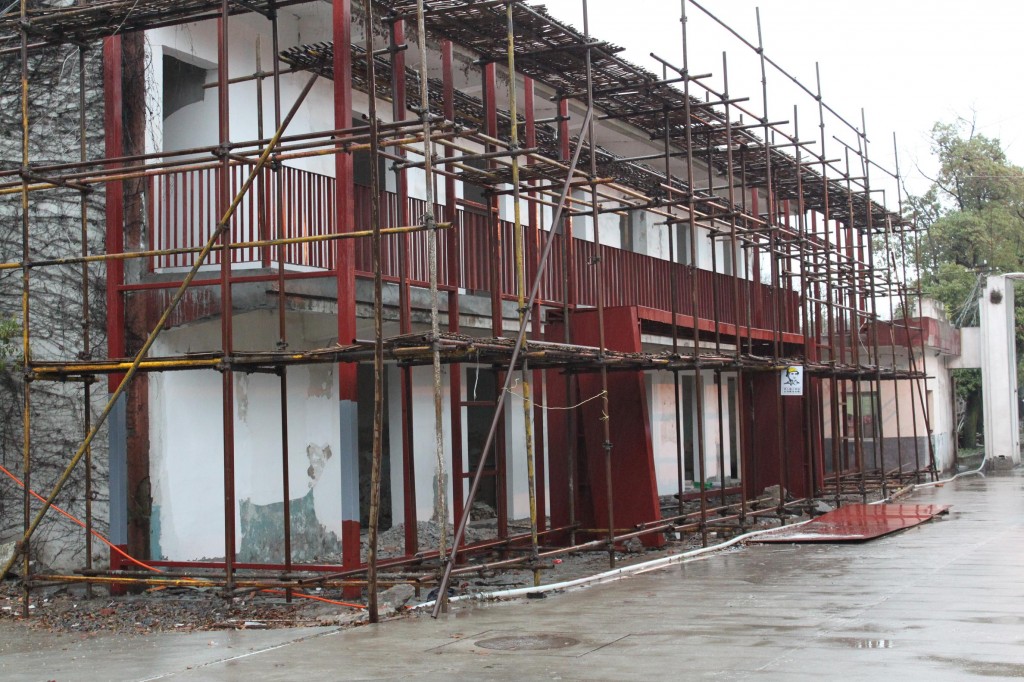
A small, cute garden got reserved~~In those days, most state-owned factories had such facilities (small area for leisure)…so… while mothers and dads were working in the workshop, their children can play  around or do homework ~~
PS: Loft group No.3 is here, proposing for planar and 3D design,film and image design, and the relevant allocation.
ä¿ç•™äº†å°èŠ±å›~那个年代的国è¥åŽ‚æˆ¿éƒ½è¿™æ ·…大人上ç,å°å©è¿˜æœ‰ä¸ªåœ°å¯ä»¥æ’’野~~
PS:3å·ç»„楼集åˆå¹³é¢ï¼Œ3D设计,电影和形象设计åŠå…¶ä»–相关é…ç½®

By reading after the planning map, it seems that this group of lofts hasn’t been appointed any specific business type…Will it be the place only for eating and drinking (reserved for consumption)?~~
仔细对照规划图, å‘现这组楼用途ä¸æ˜Ž,éš¾é“是åƒåƒå–å–区?~

Loft group No.5 for film industries…several independent Lofts, one sticking to another…Not sure how to use, but it could be a perfect place for film studio, right?!
5å·ç»„楼~~摄影行业。一个一个独立的框架LOFT…éš¾é“是摄影棚~~

This should a huge job of “replacing”~~almost rebuilding the workshop~~only the underground basis got saved!
这个翻的彻底了~~就差没撬地基了!

Simple and clean roof…functions well too~~
简å•æ¸…爽功能ä¸å¼±çš„屋顶~~

The “Uniform” of the outsider walls~
统一的外墙~~ 
An overall view~
整体效果一览~

The buildings are short…lane is not too narrow…which is good for eyesight and walking experience~
å°çŸ®æˆ¿åŠ 宽间跅视野很好ä¸åŽ‹è¿«~~

No.6-7 for decoration and university students field work base.
6-7å·åŸºåœ°ï¼šè£…饰类,大å¦ç”Ÿåˆ›æ„区
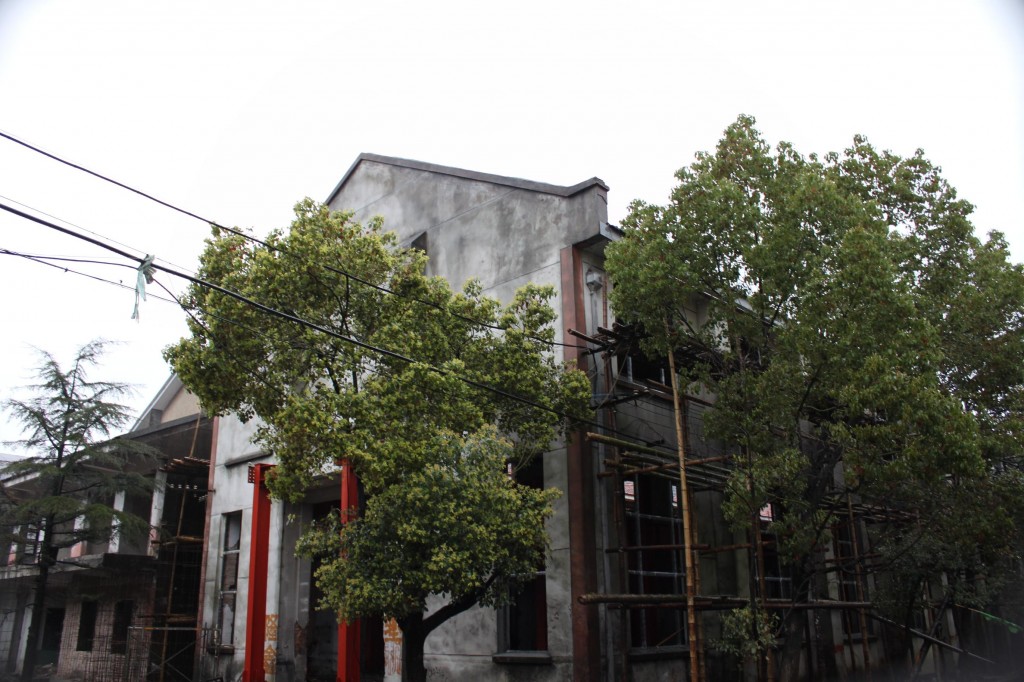
Loft No.7 was formerly a heat treatment workshop…really really huge…
7å·æ¥¼å‰èº«æ˜¯ä¸ªçƒå¤„ç†è½¦é—´,很大很大…
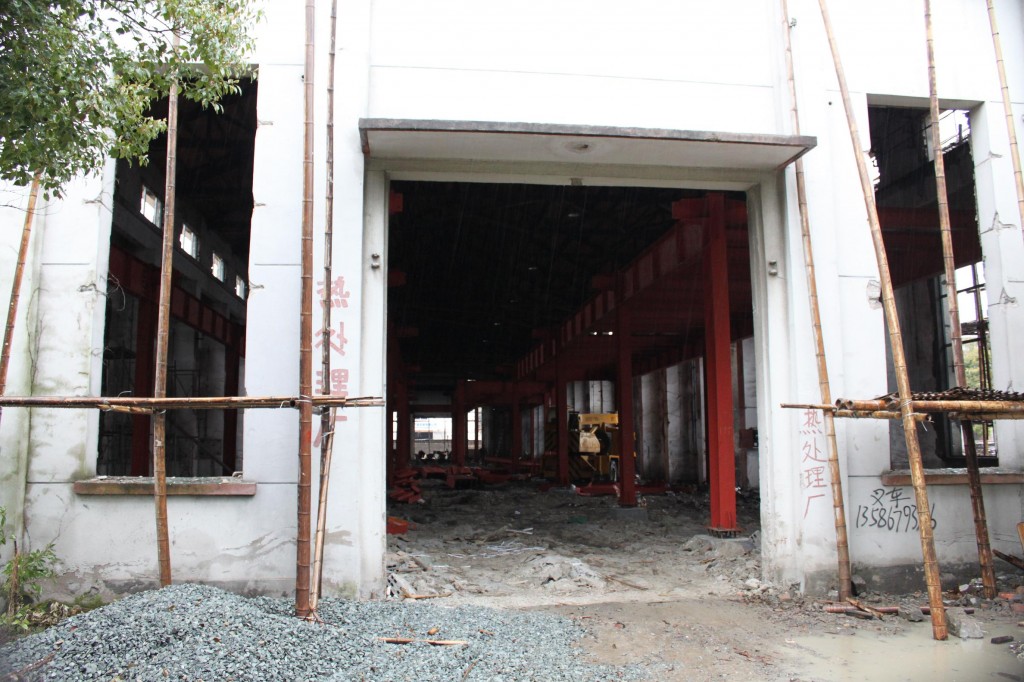
The roof should be new one…here is a zoom-in detail picture: the steel skeleton with bright red colour looks impressive and powerful…
顶应该是掀过了æ¢æ–°çš„~细节图~~红色的新骨架很亮眼很扎实亚~~
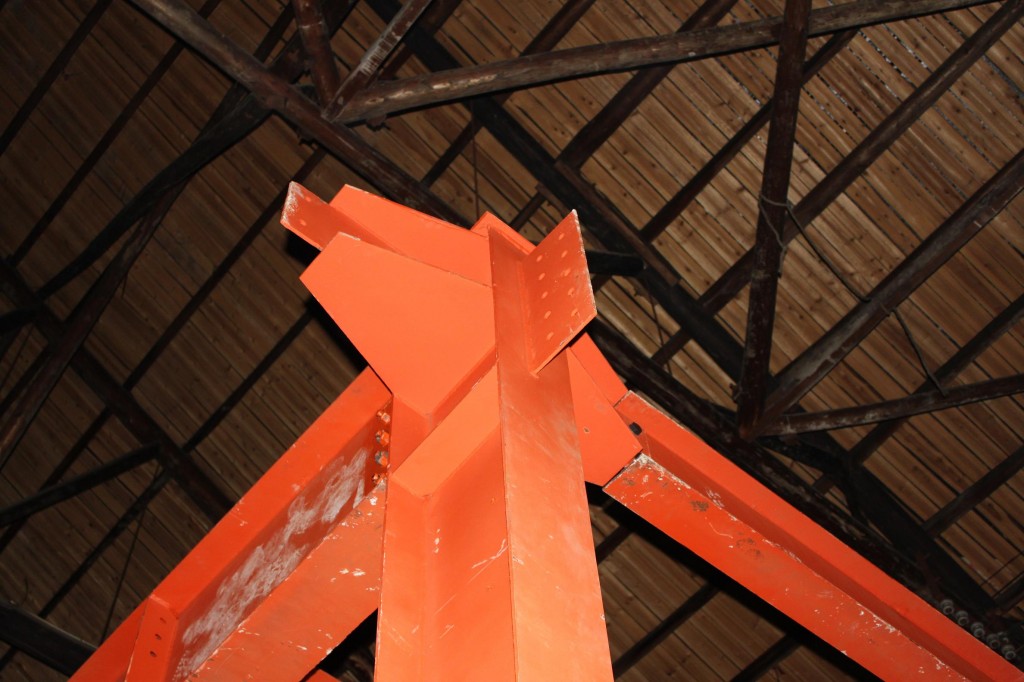
Should this old chimney be packaged into a creative vintage landmark?!
大烟囱会被包装æˆåˆ›æ„åœ°æ ‡å—?!
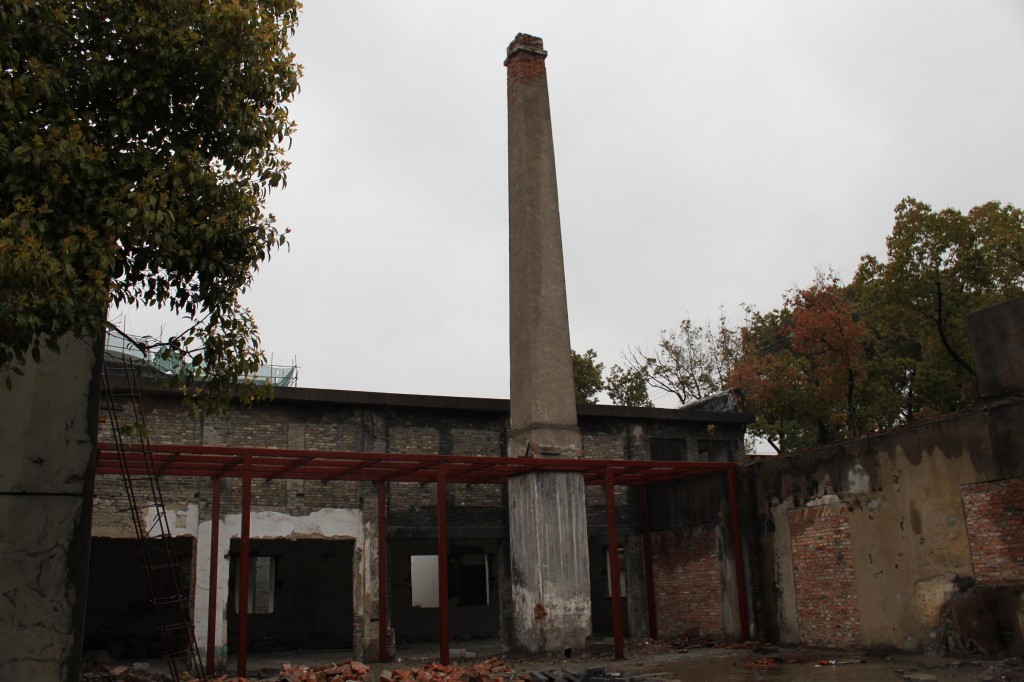




































































Recent Comments